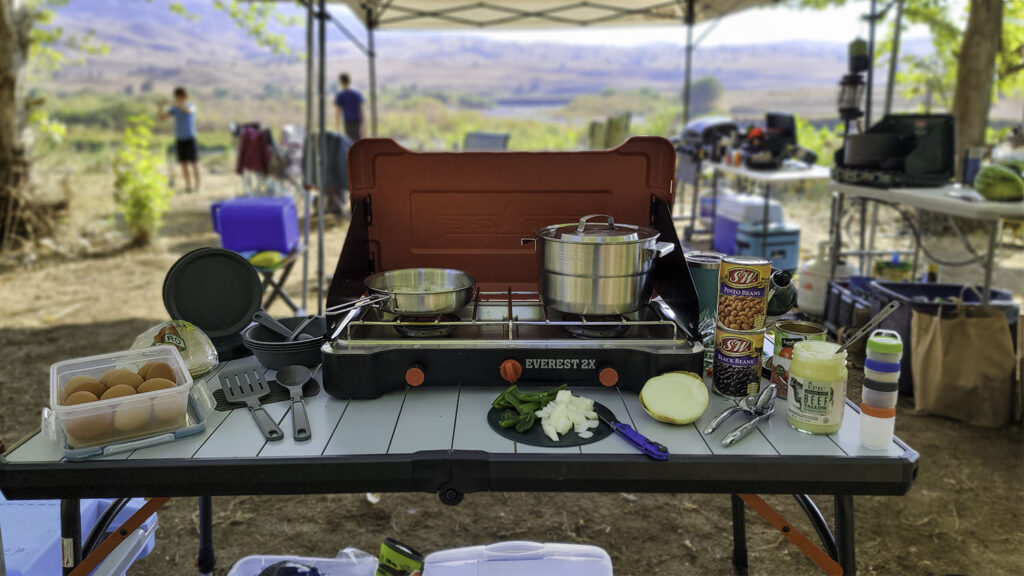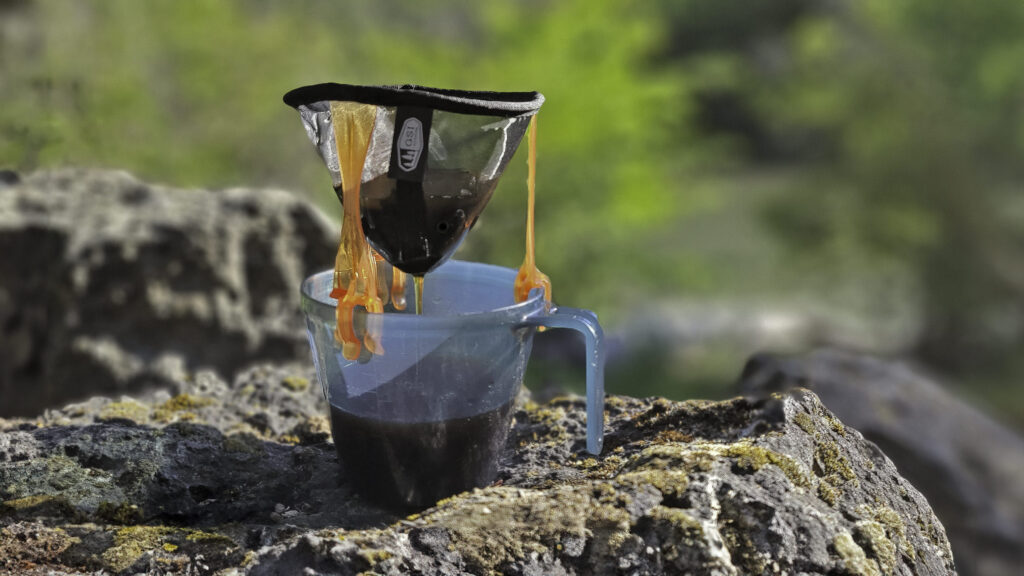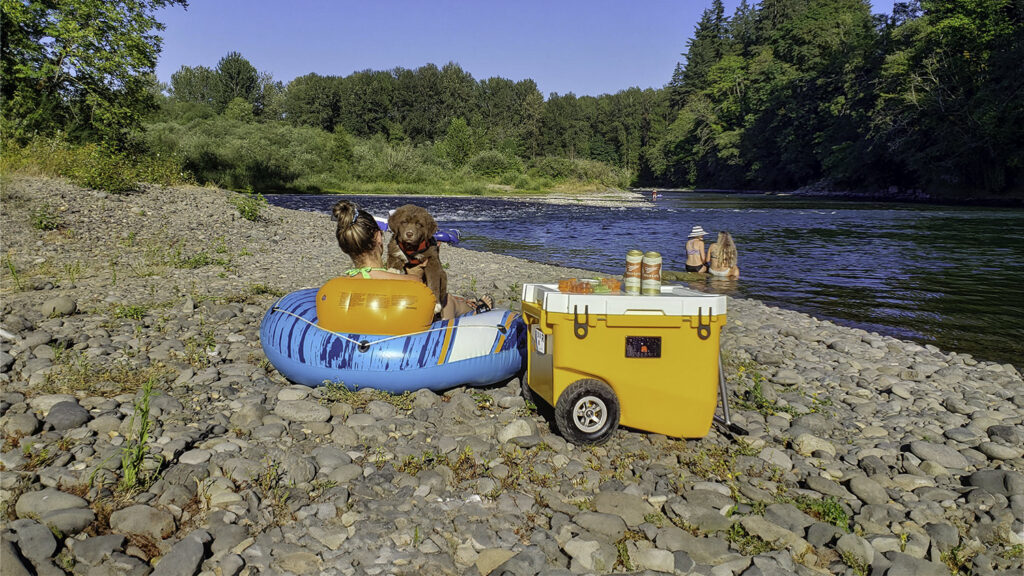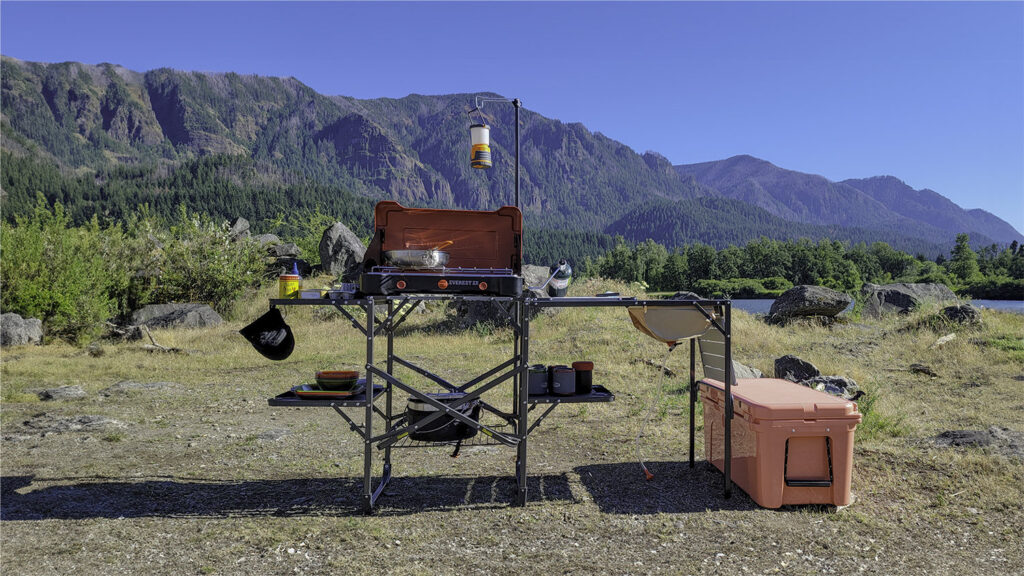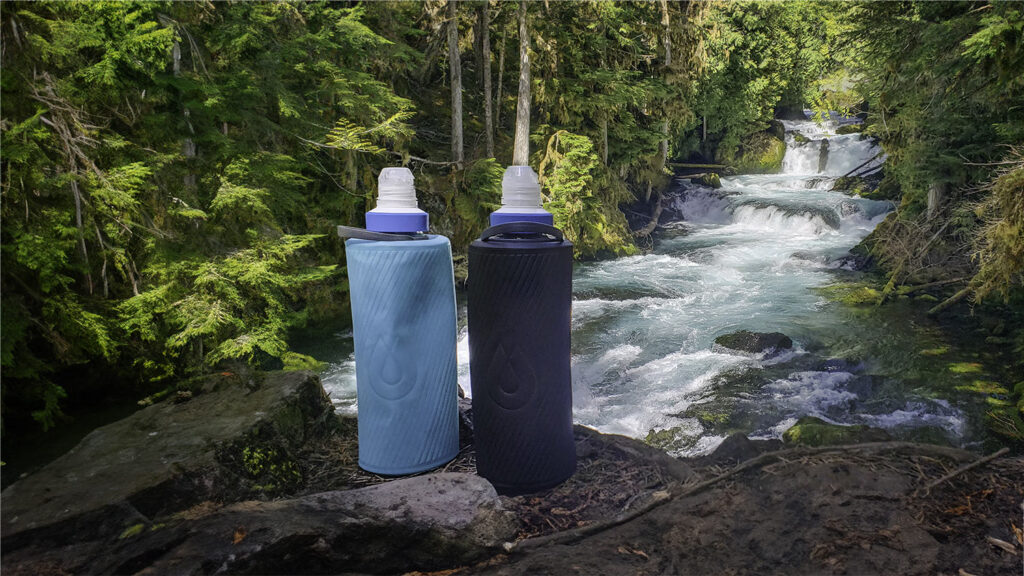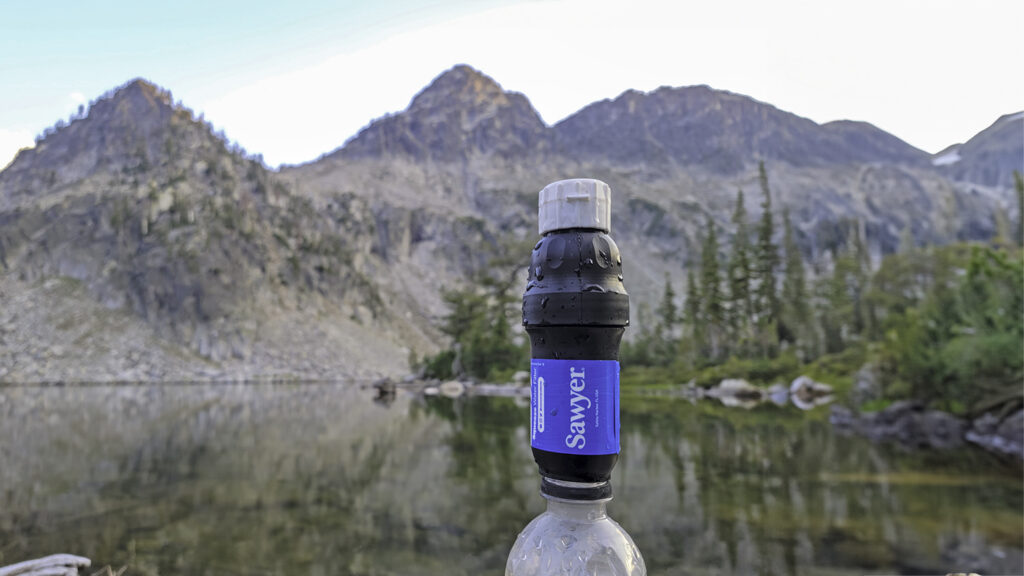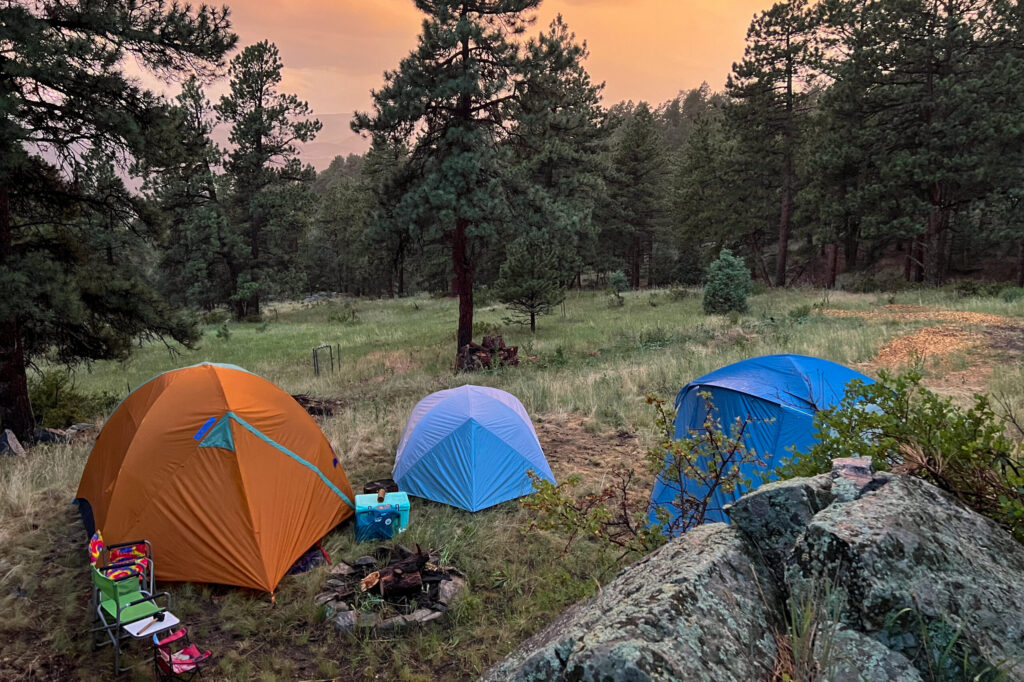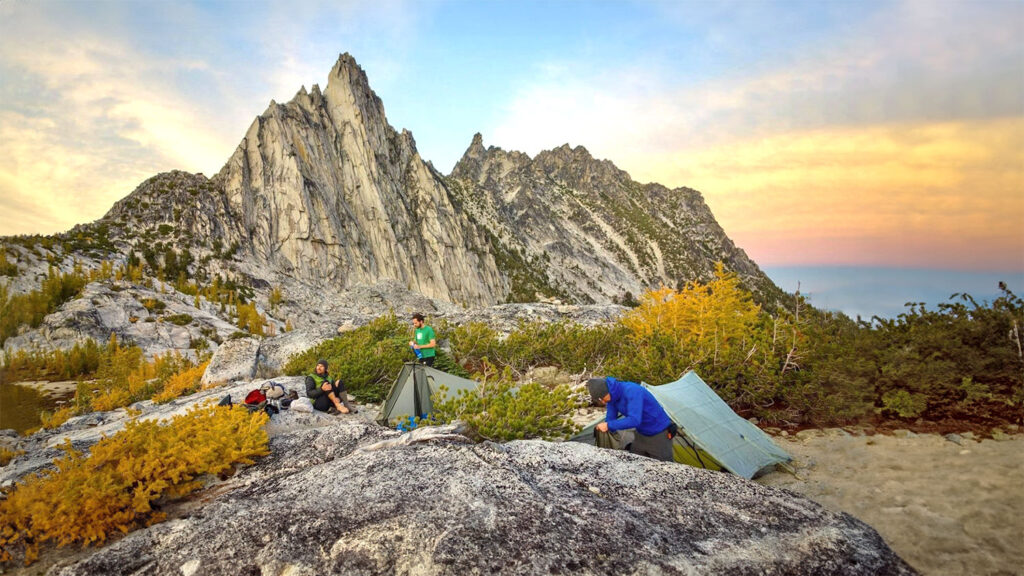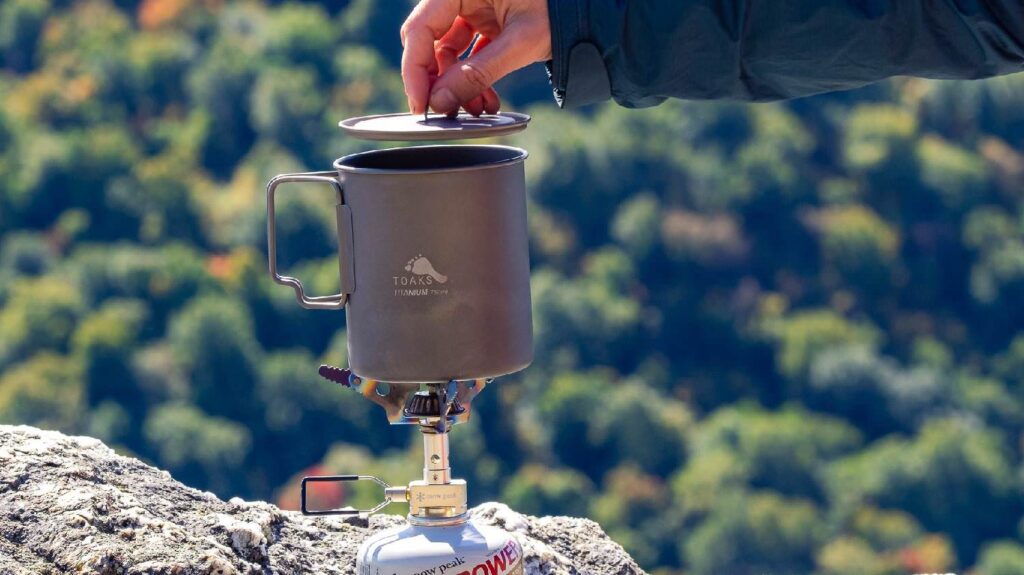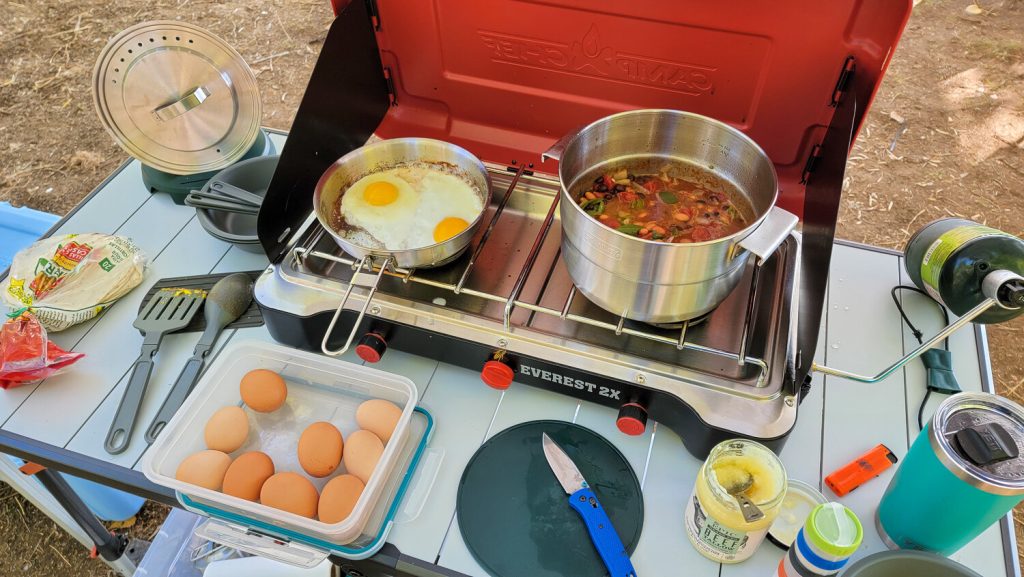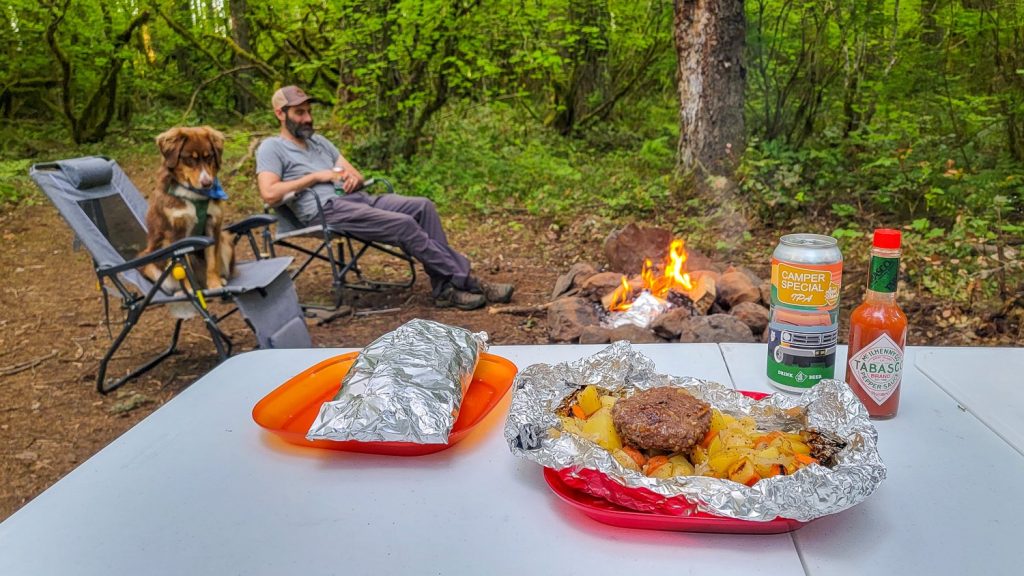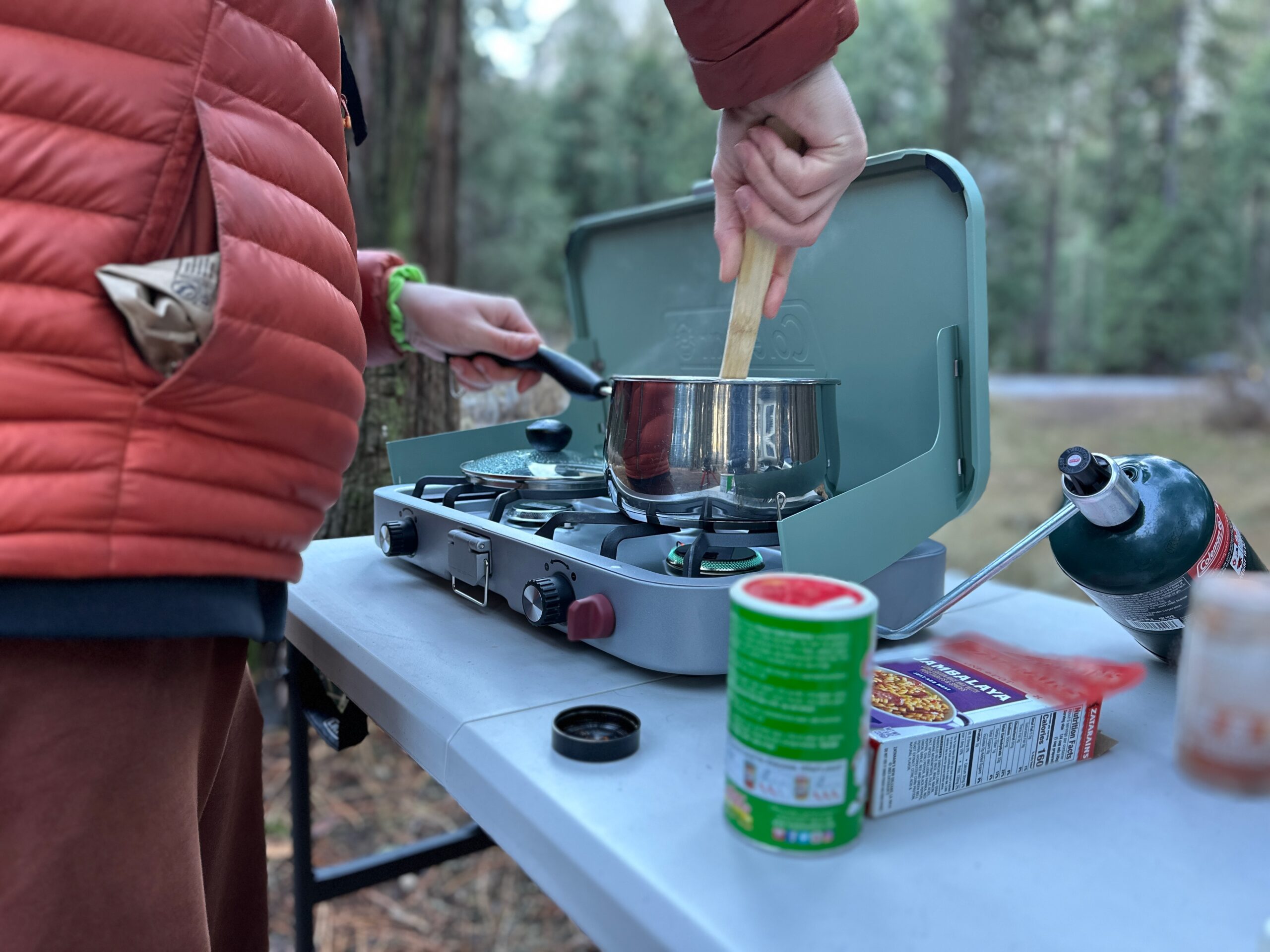
The right camp stove can mean the difference between a relaxing and rewarding evening and a frustrating one. Our team members are well versed in outdoor cooking From high-desert camps to stealth sites hidden at high mountain passes, we researched over 50 models and tested the 9 best camping stoves to put this list together.
This guide is aimed to inform you of the most efficient, fastest-cooking, best cooking, easiest to get around, and easiest to operate camp stoves there are on today’s market. We tested models from Coleman, Jetboil, Solo, Snow Peak and more to figure out which ones will bring you the Michelin star trail experience you deserve.
And for more info, check out some of our other most popular gear guides:
Quick Picks for Camping Stoves
Burn through our quick list of camping stoves below, or turn up the heat and keep scrolling for our thoughtful and in-depth reviews.
Best Camping Stove Overall: Snow Peak Home & Camp Butane Stove ($130)
Best Dual Fuel Compatible Camp Stove: Gas ONE GS-3400P ($40)
Best Versatility: Coleman Cascade 3-in-1 Camp Stove ($210)
Most Dependable Camping Stove: Coleman Cascade Classic 2-Burner Camp Stove ($75)
Best Self-Contained System: Jetboil Genesis Basecamp ($400)
Best Budget Buy: Coleman Classic 1-Burner Butane Camping Stove ($35)
Best for Big Groups: Camp Chef EX60LW Explorer 2 Burner Outdoor Modular Cooking Stove ($150)
Best Griddle Top Stove: Blackstone Original 17″ Tabletop Griddle with Hood ($159)
Best Wood Burning Camp Stove: Solo Stove Campfire ($100)
What’s New
We’ve been hard at work in our camp kitchens testing a bunch of new models and making updates to the list based on our recent findings.
- We were very happy to include some new stoves like Snow Peak Home & Camp butane stove which really delivered.
- We added a new Camp Chef stove that stands alone and has a great capacity to cook for large groups.
- We traded in the Gas ONE GS-1000 for the dual fuel capacity Gas ONE GS-3400P.
- We were also excited to test the Blackstone Original 17″ Tabletop Griddle, and it sure did deliver.
Camping Stoves Overall Testing Scores
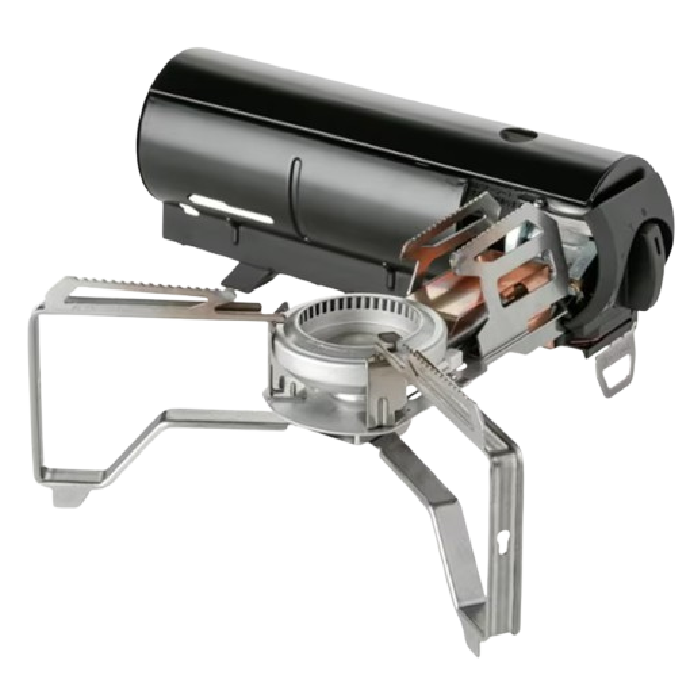
Snow Peak Home & Camp Butane Stove
Best Camping Stove Overall
CleverHiker Rating: 4.8/5.0
Price: $130
Weight: 3 lb.
Boil Time: 5:11
Fuel Efficiency: 0.4 oz.
Number of Burners: 1
BTUs (per burner): 8,333
Fuel Type: Butane
Pros
- Compact & self-contained
- Extremely packable
- Powerful for small size
- Auto-ignitor
- Easy to use
- Works with pots up to 12"
Cons
- Butane only
- Not great for windy, freezing, or high-altitude camps
- Not intuitive to set up
There’s a reason the Snow Peak Home & Camp Butane Stove is our number-one-rated camp stove of 2025. It cooks quickly and well, has a sleek design, is lightweight, and packs up as small as a reusable water bottle.
It is a snapper of a stove. It has the highest BTU rating out of our favorite single-burner stoves – 8,333 BTUs. This power shows up when boiling water. This is the quickest stove to boil water, taking just over five minutes.
Though it’s fast and hard, it can simmer a pot of rice like a dream and cook a pan of bacon evenly. Convenient features, like an easy-to-read temperature gauge, make it easy to control the flame and heat.
It’s a great value because it is packable and can travel anywhere, making it perfect for quick meals on the go and stealth camping setups.
Our first downside to this stove is that it runs exclusively on butane which limits when and where it can effectively run. The only other downside to this stove is that the design isn’t as intuitive as other camp stoves out of the box and can take some getting used to.
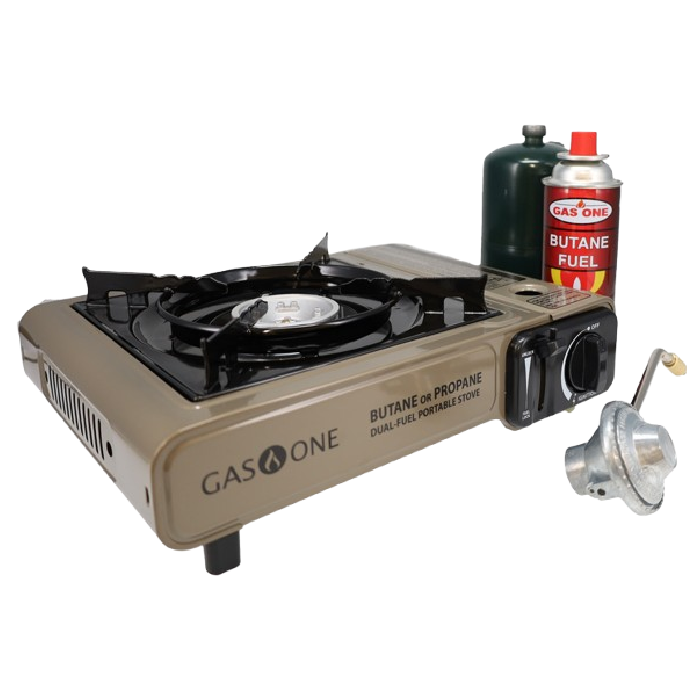
Gas ONE GS-3400P
Best Dual Fuel Compatible Camp Stove
CleverHiker Rating: 4.7/5.0
Price: $40
Weight: 3.1 lb.
Boil Time: 8:29
Fuel Efficiency: 0.6 oz.
Number of Burners: 1
BTUs (per burner): 8,000
Fuel Type: Butane or Propane
Pros
- Price
- Lightweight
- Loaded with safety features
- Auto-ignitor
- Intuitive design
- Uses propane and butane
Cons
- No wind guard
- Low-temperature setting is inconsistent
The Gas ONE GS-3400P is our number two stove in 2025 because of its versatility, quick and reliable cooking, and intuitive design.
This stove is an excellent beginner’s stove that more advanced camp chefs will appreciate as well. It has easy-to-use features, travels very well, has amazing power, and can use either propane or butane. Our drawbacks to this stove are limited and mostly about compromises made to ensure the lightness of this stove –– things like windshields that may not bother you if you prioritize light and quick.
As a single burner, this stove can limit the meals you might want to make on it. If you have a cookbook full of one-pot meals, this may not be a drawback for you. However, if you are the one to love bacon and pancakes with your eggs (and for them all to be hot at the same time), this stove may not be a great option. One thing we missed from this stove was a wind guard, but we know that this omission helps keep this stove light and easy to fit into its little case to transport. And boy, does this thing transport easily!
We love that this stove is one of the most versatile of our favorite camp stoves, enhancing its already great value. It can be used with either propane or butane, giving first-time users a chance to try out both fuel types. This dual-fuel feature also allows this stove to work well in all temperatures (as butane doesn’t perform well below 31 degrees). There’s no reason to leave this one at home for your next adventure.
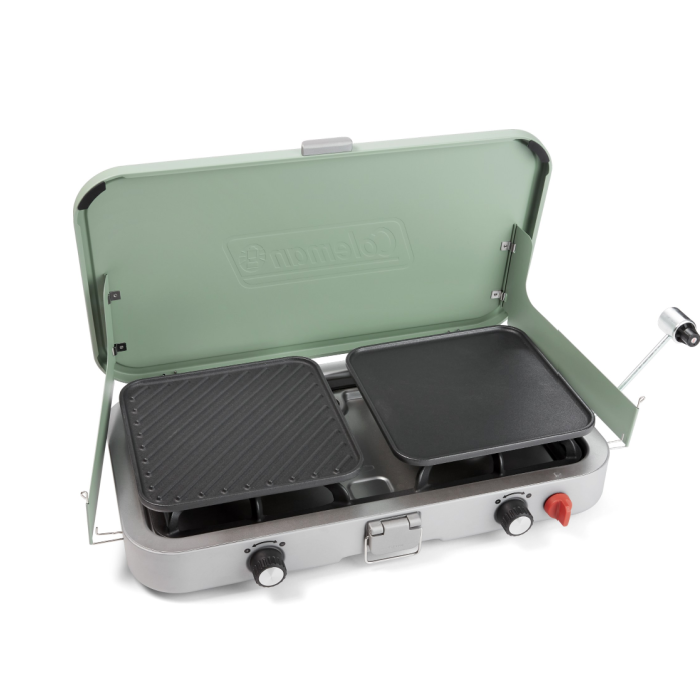
Coleman Cascade 3-in-1 Camp Stove
Best Versatility
CleverHiker Rating: 4.6/5.0
Price: $210
Weight: 14.8 lb.
Boil Time: 9:24
Fuel Efficiency: 0.9 oz.
Number of Burners: 2
BTUs (per burner): 12,000
Fuel Type: Propane
Pros
- Powerful
- Versatile
- Wind guards
- Easy to travel & pack
- Intuitive use & setup
- Auto-ignitor
- Storage for fuel attachment
Cons
- Price
- Weight with both attachments
The Coleman Cascade 3-in-1 camp stove is our number three pick this year because of its smart features, intuitive design, accessories, and cooking ability. Particularly impressive is this stove’s ability to pack down and carry into camp. The hidden handle made for easy transport, while thin (yet sturdy) windshields fold into the top. It also has storage for the fuel attachment. When folded up, this stove is thin and light.
Another thing we love about this stove is its versatility. Its two cast iron attachments allow camp chefs to pull out all the stops. The stove comes with a griddle and grill top that fit perfectly on the stove’s grate. We found the attachments easy to use and appreciated how much more we were able to cook with them. They do require some extra care and maintenance as they are cast iron. Be sure to wipe these down after use and season between uses.
The attachments add to the weight of the stove (clocking in at 14.8 pounds for the total package) but they do come in a convenient-to-carry case.
Finally, the stove has a built-in ignition and a wide range of flame output. We were able to set this stove too high so that we could get a nice char on our burritos from the grill attachment but also could set the flame low enough (and steady enough) to cook a perfect pot of rice.
For the price, this stove delivers on the value. It gives you a little bit of everything you might need from a camp stove.
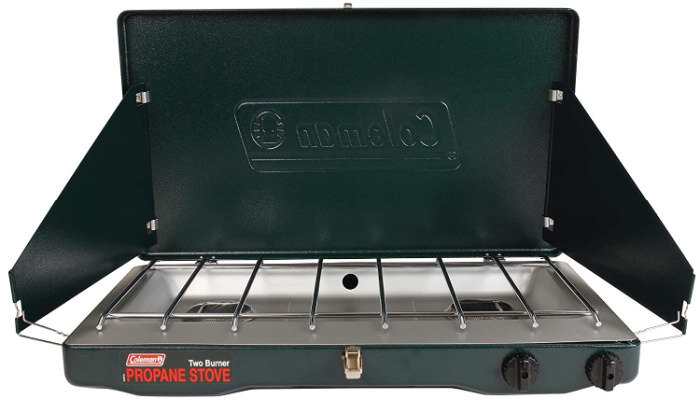
Coleman Classic 2-Burner
Most Dependable Camping Stove
CleverHiker Rating: 4.5/5.0
Price: $75
Weight: 11.65 lb.
Number of Burners: 2
Boil Time: 10:26
Fuel Efficiency: 0.8 oz.
BTUs (per burner): 10,000
Fuel Type: Propane
Pros
- Price
- Adjustable windshields
- Fuel attachment storage
- Handle for easy carry
- Lightweight
- Cooks evenly
- Simmers well
Cons
- No auto ignition
- Not as powerful as other 2-burner stoves
Another Coleman stove! The Cascade Classic 2-Burner made the list as our favorite pick for a dependable stove. It shares the sleek, packable design as the Coleman 3-in-1 but lacks some of the power and efficiency.
One of our favorite features of this stove was how easy it was to pack and carry into camp. It has a slim design that makes it easy to fit into the Tetris of a packed car. It is a simple, reliable design that also makes it easy and dependable to operate.
When testing three stoves side-by-side, our gear analysts enjoyed cooking on this stove more so than either of the other two, without question because of how easy it is to use and how consistent the cook is. When running frantically around from stove to stove, this one was steady and didn’t need much attention — a feature we appreciate in camp settings when there are usually many distractions.
We wish that the stove had a built-in ignition, but we don’t have major complaints beyond this. Yes, it lacks some power that other stoves deliver, but power isn’t the metric that everyone needs from their camp stove. We would take a perfectly cooked pot of rice over a super powerful stove.
This Coleman upholds the brand’s reputation well. It is reliable, easy to use, and cooks a good pot of rice –– even outperforming a $400 camp stove! The drawbacks are slight and shouldn’t deter the average camp chef or beginner cook, though someone looking for more power and efficiency might want to look at some of our other favorite camp stoves.
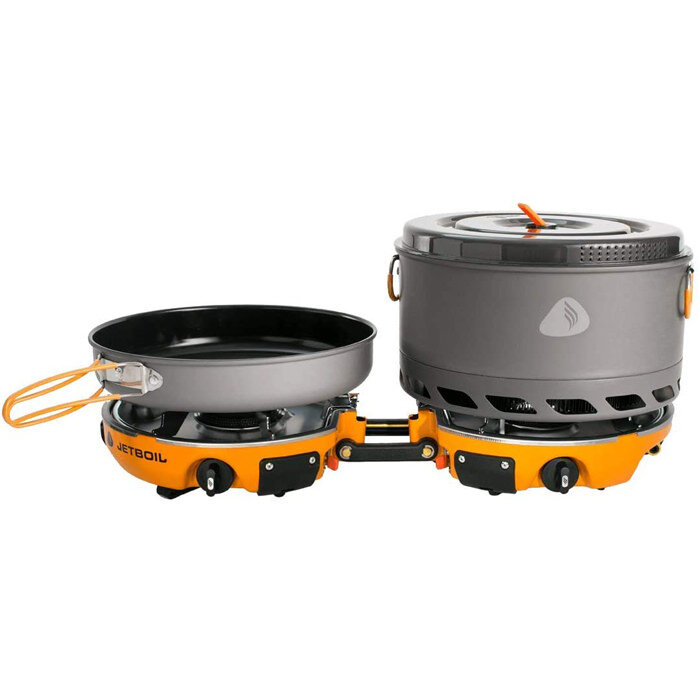
Jetboil Genesis Basecamp System
Best Self-Contained System
CleverHiker Rating: 4.6/5.0
Price: $400 (includes cookware)
Weight: 9.1 lb.
Boil Time: 7:21
Fuel Efficiency: 0.7 oz.
Number of Burners: 2
Fuel Type: Propane
BTUs (per burner): 10,000
Pros
- Packable
- Includes pot/pan
- Auto-ingnitor
- Intuitive design
- Quick boil time
- Excellent accessories
Cons
- Very expensive
- Common complaints of faulty regulators
- No wind guard
- Not the best for simmering
- Can cook unevenly
We thought the Jetboil Genesis Basecamp System would be in our top three picks this year, but found some issues that pushed it down to our fifth pick. It has a smart packing system and is very easy to use. It boils water quickly with low fuel use. However, we were disappointed in its ability to simmer and cook evenly.
This is more than a stove; it’s a system. It comes with the Genesis Stove, a 10-inch fry pan, a 5-liter pot and lid, and a carrying bag. The stove folds in half (like a waffle maker) and nests inside the pot. The pot’s lid sits on top of the stove and then the pan tops it all. It slides easily into the carrying bag. It fits well in crowded cars and stores well at home. We loved that the carrying case also has a velcro pocket to stash the fuel attachment.
The second reason why we love this stove is that it is also very easy to use. It features a built-in ignition and stable design. It has temperature controls that allow the flame to get really low.
However, when put to the test, we found that this stove didn’t simmer as well as others we tested nor did it produce an even cook. It did, however, cook very quickly and with a lot of power. With the right monitoring, these cooking issues might not be issues for you. But for how pricey this stove is, we want a perfect cook every time with minimal effort.
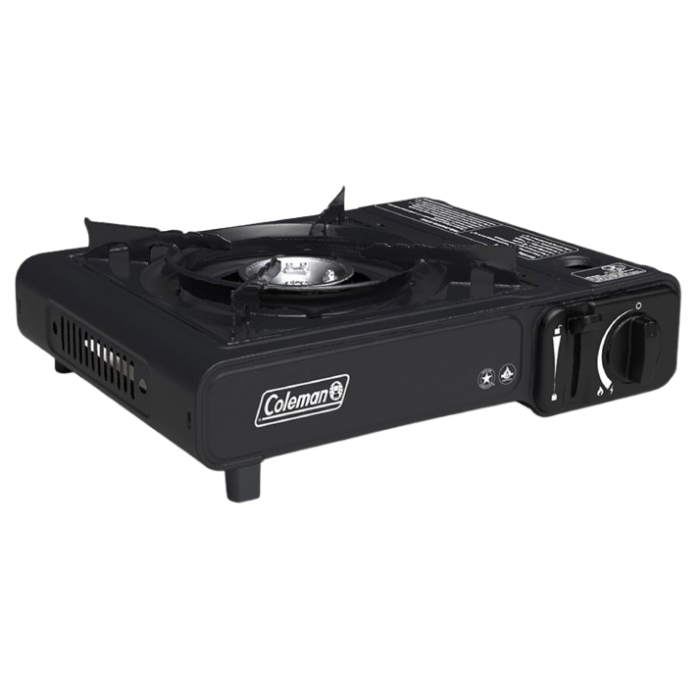
Coleman Classic 1-Burner Butane Camping Stove
Best Budget Buy
CleverHiker Rating: 4.4/5.0
Price: $35
Weight: 5.15 lb.
Boil Time: 16:08
Fuel Efficiency: 0.8 oz.
BTUs (per burner): 7,650
Number of Burners: 1
Fuel Type: Butane
Pros
- Price
- Wind baffle
- Lightweight
- Easy to use
- Auto-ignitor
- Packs and transports easily
Cons
- Weak BTU
- Butane only
- Not great in harsh weather
This Coleman Classic 1-Burner Butane Camping Stove showcases why Coleman is one of the top camp stove brands. The design is easy enough for beginners to navigate. It packs into a convenient carrying case, is one of the lightest of all our favorite camp stoves, and has an Instastart ignition. However, this stove solely runs on butane gas, providing limitations for cold-weather and high-altitude use. We found that the low setting extinguished the flame when we tried to simmer a pot of rice. It also doesn’t have the power to boil water quickly –– taking over 16 minutes to boil one liter of water.
When we tested the Coleman Classic 1-Burner, we found it to be reliable, very easy to set up, and perfect for getting food cooked fast when we were stressed about time. We appreciated the wind baffle, which is a low-profile barrier around the burner. It didn’t provide as much protection as the windscreens we used on other stoves, but it helped on a breezy evening. Packing it up was probably the best part of this stove. Its carrying case allows it to stash easily in our packed cars.
We wished that the low setting was more reliable, or that the stove was compatible with other fuel types, but overall, this stove is a great option that takes minimal thought and effort.
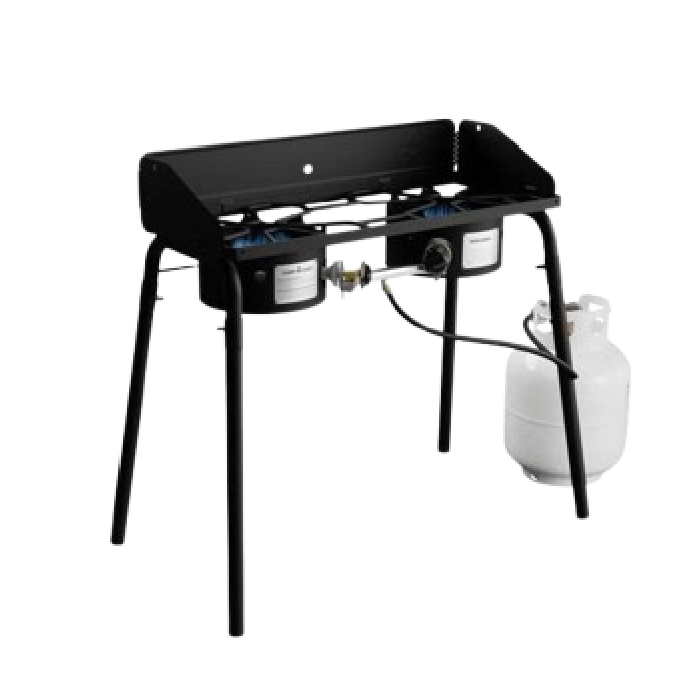
Camp Chef EX60LW Explorer 2 Burner Outdoor Camping Modular Cooking Stove
Best Camping Stove for Large Groups
CleverHiker Rating: 4.3/5.0
Price: $150
Weight: 36 lb.
Boil Time: 6:59
Fuel Efficiency: 3.2 oz.
BTUs (per burner): 30,000
Fuel Type: Propane
Number of Burners: 2
Pros
- Removable windshield
- Stand-alone stove
- Removable legs
- Powerful flame
- Wide cooking surface area for large pots/pans
Cons
- Bulky and awkward to move
- Heavy
- Not the easiest to pack
- Must use propane tank
The Camp Chef EX60LW Explorer 2 Burner Outdoor Camping Modular Cooking Stove is a beast of a stove and perfect for mult-day raft trips, family campouts and cookouts, and any outdoor cook camp where you’ll be feeding a lot of people. It is not the easiest to fit in a smaller rig that also is loaded with camping gear.
We wish we had this for tailgating or being a trail angel because it has the power and capacity to cook massive amounts of food. It’s the stove you want when you have a big crowd. It has powerful output with a wicked flame that can cook a heck of a burger just as well as it can cook a pot of rice.
This stove’s large frame is easy to clean, but it doesn’t fold or compact. The legs are removable (and adjustable) and the windscreen detaches, but the stove still takes up a lot of space in a car. On top of that, you’ll have to make room for a propane tank. This might not be a problem for someone with a truck, but doesn’t work well for a Subaru driver who is also packing other camp supplies.
Despite this, we believe this stove is a great value for someone who will use this in other settings like at home as a grill or tailgating (Camp Chef has tons of attachments that fit to this stove). It is also the stove we would recommend for a week to two-week-long camping trips.
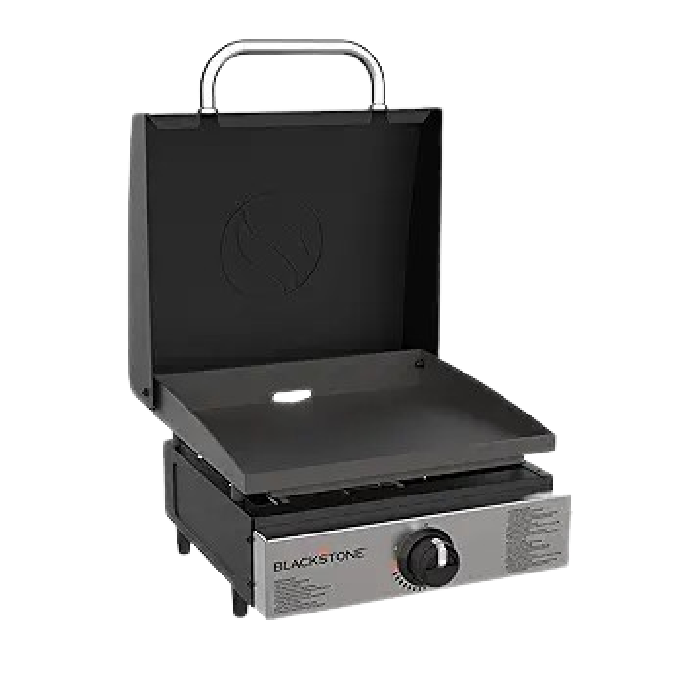
Blackstone Original 17″ Tabletop Griddle with Hood
Best Griddle Stove Top
CleverHiker Rating: 4.1/5.0
Price: $159
Weight: 35.2 lb.
Boil Time: 15:30
Fuel Efficiency: 2.2 oz.
BTUs (per burner): 12,500
Fuel Type: Propane
Number of Burners: 1
Pros
- Can cook lots of food at once
- Auto-ignitor
- Great temperature regulation
- Effective hood
- Grease trap for easy clean-up
- H-style burner creates even heat
Cons
- Price
- Maintenance/must season cast iron
- Not versatile
- Not great at boiling water
- Heavy
Though the Blackstone Original 17″ Tabletop Griddle with Hood can be cumbersome and requires more care than the average camp stove, it offers features that inspire great camp meals. With a built-in hood and cast-iron griddle top, this stove cooks evenly and well. We loved that we could sauté peppers, fry eggs, and cook bacon at the same time on the 17” griddle, allowing for a hot breakfast that all came out at the same time. However, it was not able to efficiently boil a liter of water.
There are more considerations with this grill than others in our favorites, such as care, weight, and portability. This stove is by far the heaviest and most cumbersome of the bunch. Unlike something like the Jetboil Genesis Basecamp System that we feel could take a tumbling or two in a truck bed, packing the Blackstone feels precious and must be transported with care. The cast iron that we love so much for its cooking abilities does require maintenance. Blacktop suggests seasoning after each use to prevent damage. For grilling, this stove is amazing. However, we would recommend adding a single burner –– like the Gas ONE GS-3400P –– to boil and simmer.
For those who love setting up a raging tailgate or love lounging around camp, this stove is a great option. It can cook for large crowds easily, keep a consistent temperature in the wind, and truly makes a stunning plate of food.
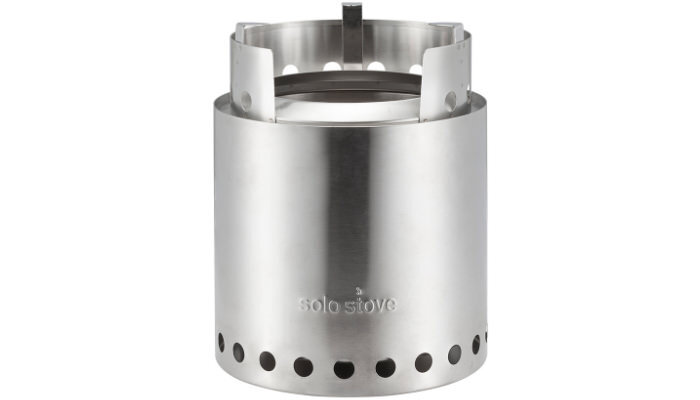
Solo Stove Campfire
Best Wood-Burning Camping Stove
CleverHiker Rating: 3.8/5.0
Price: $110
Weight: 2.2 lb.
BTUs (per burner): Varies
Number of Burners: 1
Fuel Type: Wood
Efficiency: 4.2
Boil Time: n/a
Ease of Use: 3.6
Pros
- Powerful
- Versatile
- Wind Guards
- Lightweight
- No need to buy fuel
Cons
- Can't use under fire restrictions
- Can be smokey
- Difficult to start
- Needs constant attention
- Messy
The Solo Stove is a great option for those looking for a wood-burning stove. Its design maximizes airflow so that a brilliant fire can erupt from almost nothing. However, this stove does take some getting used to. Compact and finicky, creating fire in this stove is not as easy as setting one up in a fire ring at camp. Plus, this stove requires constant attention and slowly adding fuel as overcrowding fuel can cause massive amounts of smoke.
One of the major benefits of this stove is that it does not use propane or butane to fuel. This can feel like a relief to those looking to reduce their environmental imprint. However, leaving the gas canisters at home decreases the reliability of the burn, simmer ability, and even cooking. By using natural fuel, this stove does require knowledge, skill, and patience.
When we tested, we found that the most reliable fire comes from the “second burn.” Each time we started a fire in the Solo Stove, we encountered a lot of smoke. The first time, we got a fire going, but it burned out within 2 minutes. The second, we burned through the first kindling. When we added more, the stove produced a good fire with little smoke. The third time, we overcrowded the stove with fuel and produced too much smoke (we began getting attention from other campers).
We suggest practicing building a fire on this stove before relying on it at camp for cooking food. We also suggest researching common fire restrictions in the areas you camp –– some campgrounds, counties, state park systems, etc, do not allow wood-burning stoves.
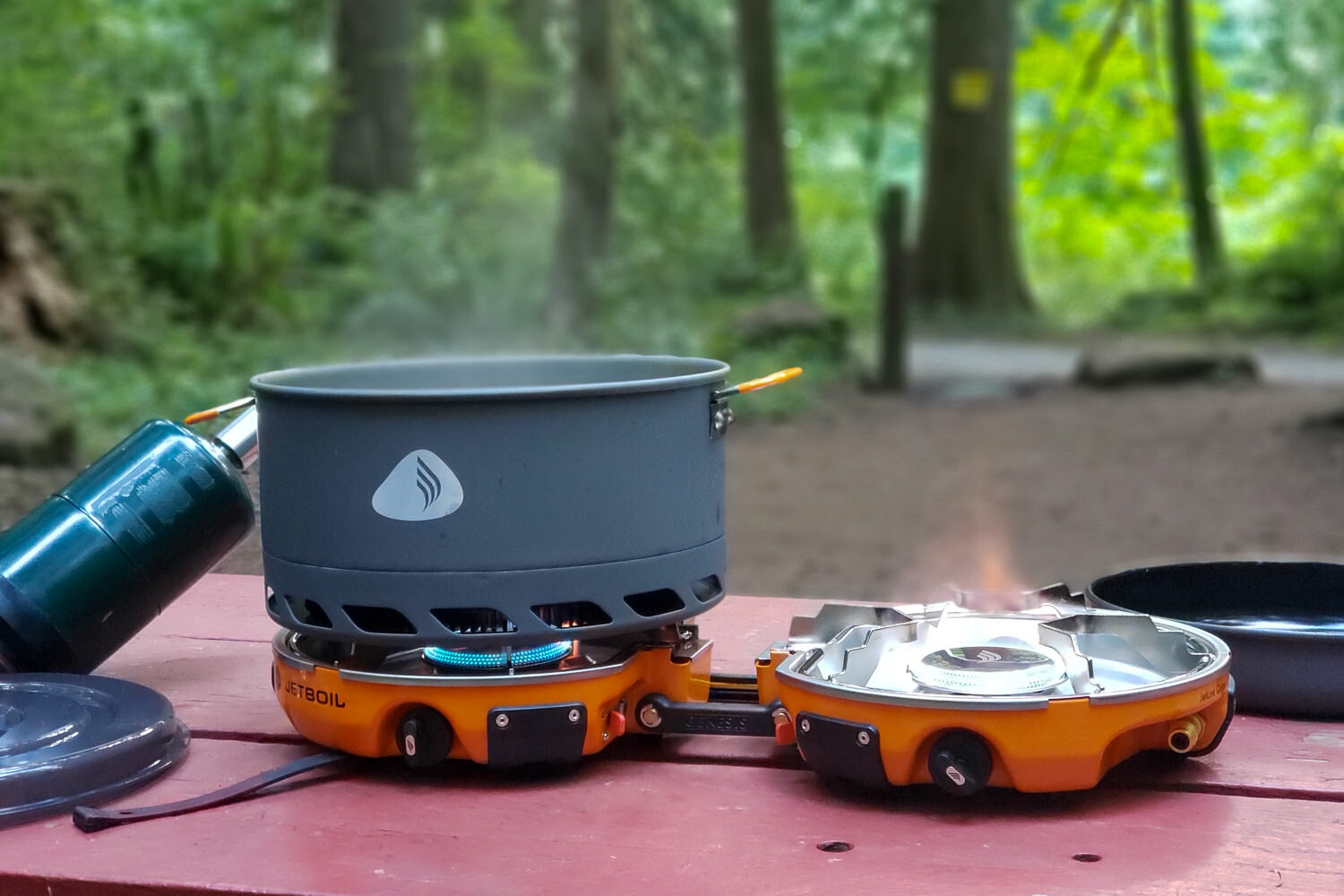
Product Comparison Table
| oSort | Product | Price | Weight | Boil Time | Fuel Efficiency | Number of Burners | BTUs (per burner) | Fuel Type | Power | Efficiency | Cooking Ability | Portability | Ease of Use | 0 |
Snow Peak Home & Camp Butane Stove View at REI View at Amazon |
$130 | 3 lb. | 5:11 | 0.4 oz. | 1 | 8,333 | Butane | 5.0 | 5.0 | 4.6 | 5.0 | 4.2 | 1 |
Gas ONE GS-3400P View at Gas ONE View at Amazon |
$40 | 3.1 lb. | 8:29 | 0.6 oz. | 1 | 8,000 | Butane or Propane | 4.4 | 4.8 | 4.6 | 5.0 | 4.6 | 2 |
Coleman Cascade 3-in-1 Camp Stove View at Amazon View at REI |
$210 | 14.8 lb. | 9:24 | 0.9 oz. | 2 | 12,000 | Propane | 4.2 | 4.2 | 4.8 | 5.0 | 4.8 | 3 |
Coleman Classic 2-Burner View at REI View at Amazon |
$75 | 11.65 lb. | 10:26 | 0.8 oz. | 2 | 10,000 | Propane | 4.2 | 4.2 | 4.6 | 5.0 | 4.6 | 4 |
Jetboil Genesis Basecamp System View at REI View at Amazon |
$400 (includes cookware) | 9.1 lb. | 7:21 | 0.7 oz. | 2 | 10,000 | Propane | 4.6 | 4.6 | 3.8 | 5.0 | 5.0 | 5 |
Coleman Classic 1-Burner Butane Camping Stove View at Coleman View at Amazon |
$35 | 5.15 lb. | 16:08 | 0.8 oz. | 1 | 7,650 | Butane | 3.6 | 4.2 | 4.0 | 5.0 | 5.0 | 6 |
Camp Chef EX60LW Explorer 2 Burner Outdoor Camping Modular Cooking Stove View at Camp Chef View at Amazon |
$150 | 36 lb. | 6:59 | 3.2 oz. | 2 | 30,000 | Propane | 4.8 | 3.6 | 4.6 | 3.6 | 4.8 | 7 |
Blackstone Original 17″ Tabletop Griddle with Hood View at Blackstone View at Amazon |
$159 | 35.2 lb. | 15:30 | 2.2 oz. | 1 | 12,500 | Propane | 3.6 | 3.8 | 4.6 | 3.8 | 4.8 | 8 |
Solo Stove Campfire View at Amazon View at Solo Stove |
$110 | 2.2 lb. | n/a | n/a | 1 | Varies | Wood | 3.6 | 4.2 | 3.6 | 3.8 | 3.6 |
|---|
How We Test & Methodology
Here, we break down the key ingredients that we look for in top camping stoves, including boil time, fuel efficiency, simmer control, ease of use, and portability. Our team cooked over 100 meals on every stove year-round and in the most extreme conditions, from freezing and snowy to wet and windy, to test how well these cooktops held up.
BOIL TIME
We conducted boiling tests for each of our stoves to test the power of each. To do so, we tested each stove in the same controlled environment. We made sure the temperature was consistent. We also made sure there was no wind or other elements that could interfere with our test.
We used the same pot for each test and filled it with exactly one liter of room-temperature water. We set each stove to medium heat. As soon as we set the pot of water on the burner, we began a timer. At the end of testing all of the stoves, we were able to see which stoves had the best power.
The boiling test was performed at around 4,500 feet above sea level. Boil times change as you gain or lose elevation. You should expect stoves that are at sea level to take more time to boil than what our tests show. Likewise, boiling water on these stoves above 5000 will take less time. Generally, with each 500-foot gain in elevation, water decreases its boiling point by 1 degree Fahrenheit. Note that although water boils faster and at lower temperatures while at altitude, cook times actually increase.
FUEL EFFICIENCY
We thought it was important to note not only the difference in time for each stove to boil water, but also how much fuel it took to do so. By measuring the fuel level, we’re trying to gauge which stoves are more efficient and help you save money on propane or butane.
To test this, we weighed the bottle of either propane or butane before we started our boil test and immediately after. We noted the difference between the weights. We also researched each stove to see what sort of technologies they may utilize to maximize their heat output –– like integrated heat exchangers and radiant burner designs.
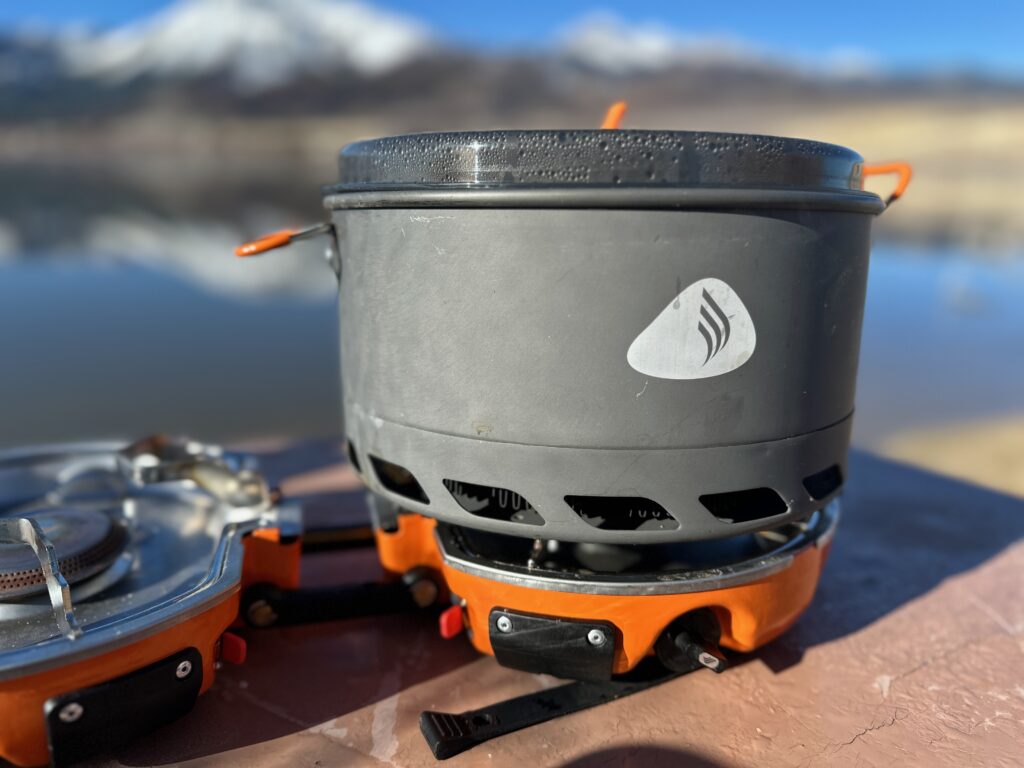
COOKING ABILITY
A stove’s cooking ability depends on a few factors:
- Ability to keep consistent flame at different levels
- Evenness of cooking
- Versatility of the stove
We tested these aspects in two different ways and considered features of the stove to round out our evaluation of a stove’s cooking ability.
First, we tested the simmering ability by cooking rice on each stove. A pot of rice requires low heat for 20-30 minutes. We made sure to note which stoves could not maintain a low temperature (some were extinguished when set to low after a few minutes), how well the water was absorbed, and how fluffy and thoroughly cooked the rice was at the end of its cook.
Secondly, we wanted to see if each stove could cook evenly throughout a pan or its griddle/grill tops. To test this, we chose food options like bacon, pancakes, hamburgers, and buns. Each stove was tested with at least one of these options and we would ensure that each pan or flattop would have food at the top, middle, and bottom of its cooking surface.
Finally, we considered features like wind guards and temperature controls that may enhance a stove’s ability to cook well.
PORTABILITY
Portability is important because if a stove doesn’t pack well or is too awkward, it’s probably not something you want to take to camp. To assess this metric, we evaluated the stove’s weight, packed dimensions, features like handles for carrying, how each stove packed into our car, and if we could easily unload each stove with our hands full. This combines both quantitative and qualitative factors, giving equal importance to each.
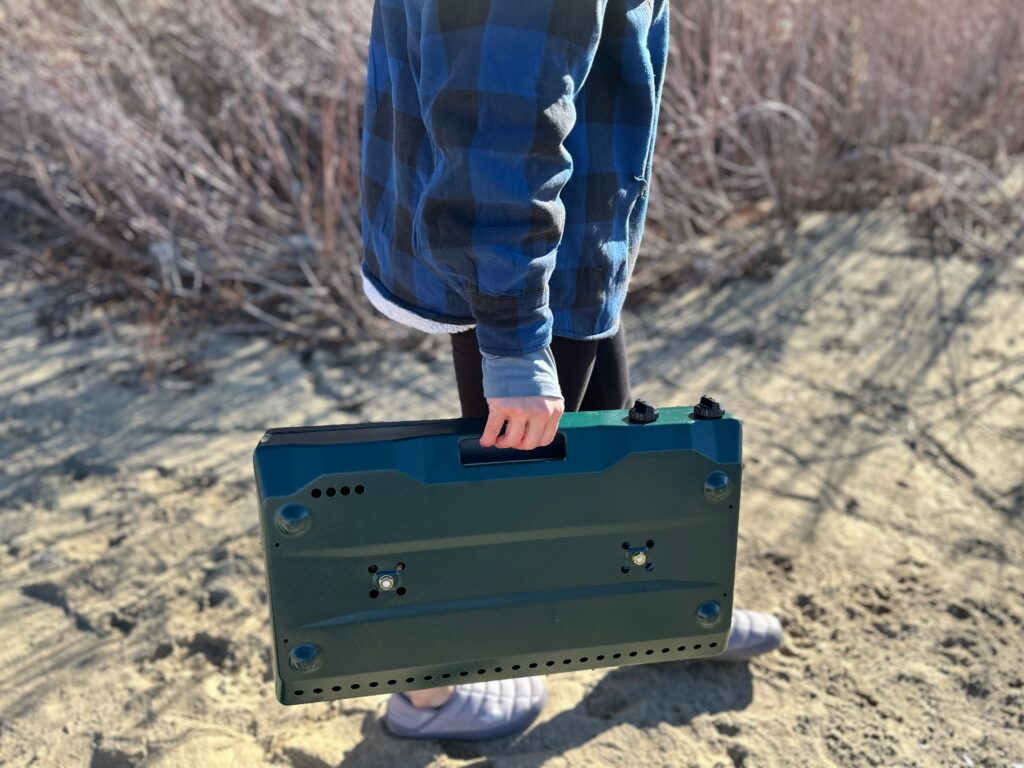
EASE OF USE
We measured ease of use with the mindset of what would feel intuitive for a beginner camp stove user. We thought about the following attributes while testing: simplicity of assembly, ease of connecting to fuel sources, method of ignition, if the stove has supports to stabilize the surface, and finally, we assessed how difficult each stove was to clean.
When we took each stove out to cook at camp, we wanted to be able to use it for the first time in the field while frantic with hunger. These conditions mirror an experience we frequently have –– coming back into camp after a long day of adventure, ready for a hot meal. We took into account the features of each stove but placed a lot of emphasis on actual performance under pressure.
OTHER CONSIDERATIONS
Fuel type is a major consideration. We tested butane, propane, and wood-burning stoves. Each has benefits and drawbacks. Generally, we found that propane stoves are the most reliable though butane stoves are more powerful when operated when outside temperatures are above 40 degrees, and wood-burning stoves run on renewable resources (like sticks around camp).
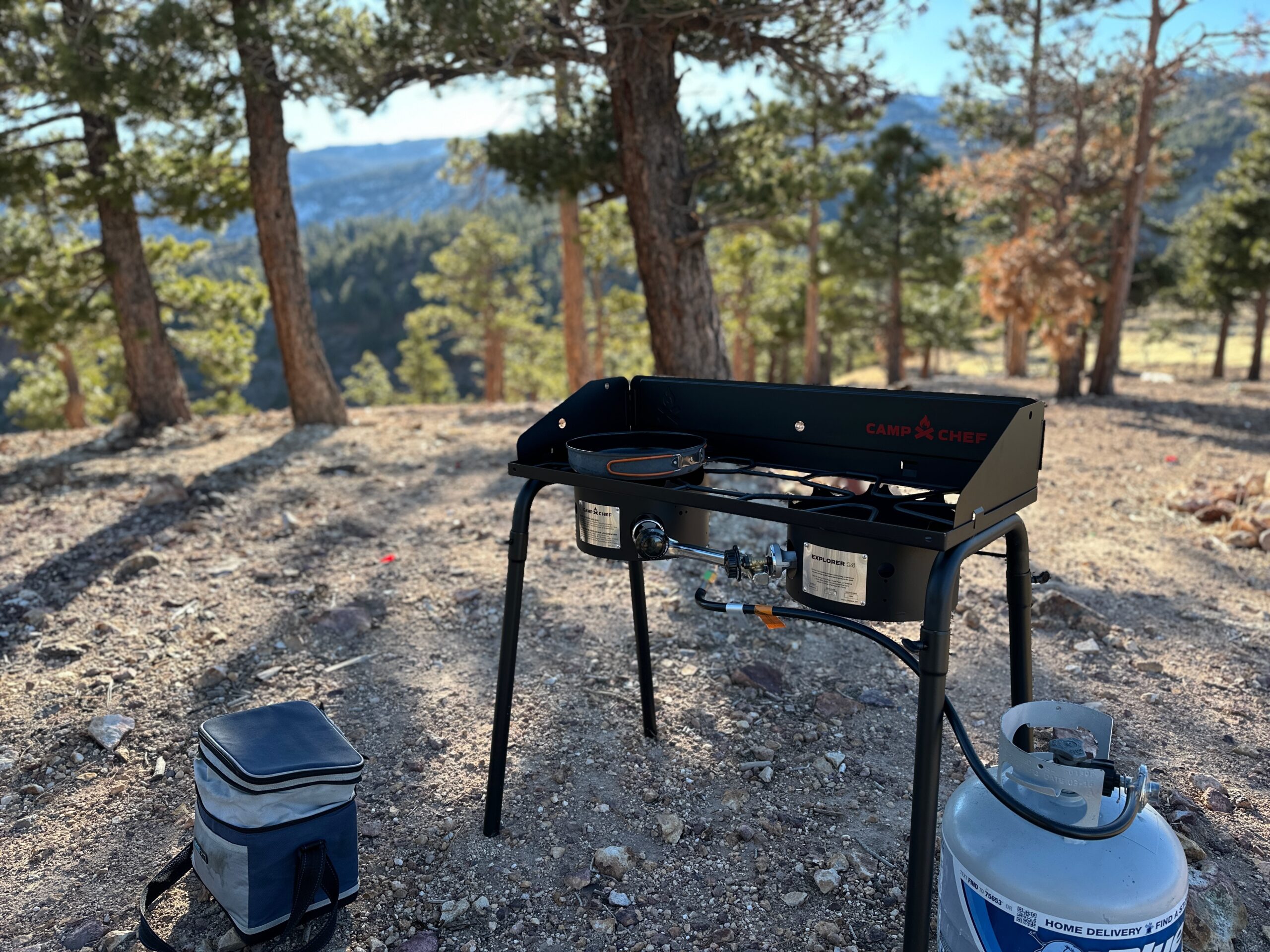
Why Trust CleverHiker
We take camp meals seriously. With over 50 nights of camping in 2024, our gear analyst Helena Guglielmino has tried countless meals on countless camp stoves. She once spent six months living out of her Subaru, cooking the majority of her meals on a single-burner camp stove but now spends the majority of her time camping in the Sierra Nevada, pulling up to stealth spots by her favorite lakes, rivers, and passes along with the valleys that line the eastern side of the range. She almost always spends her days before camping hiking long, tough miles and arriving back to camp in need of a big meal.
Her experience has given her a great understanding of what a stove needs to perform well. She knows that power, even cooking, easy setup, and packability are major benefits to getting a delicious meal cooked quickly.
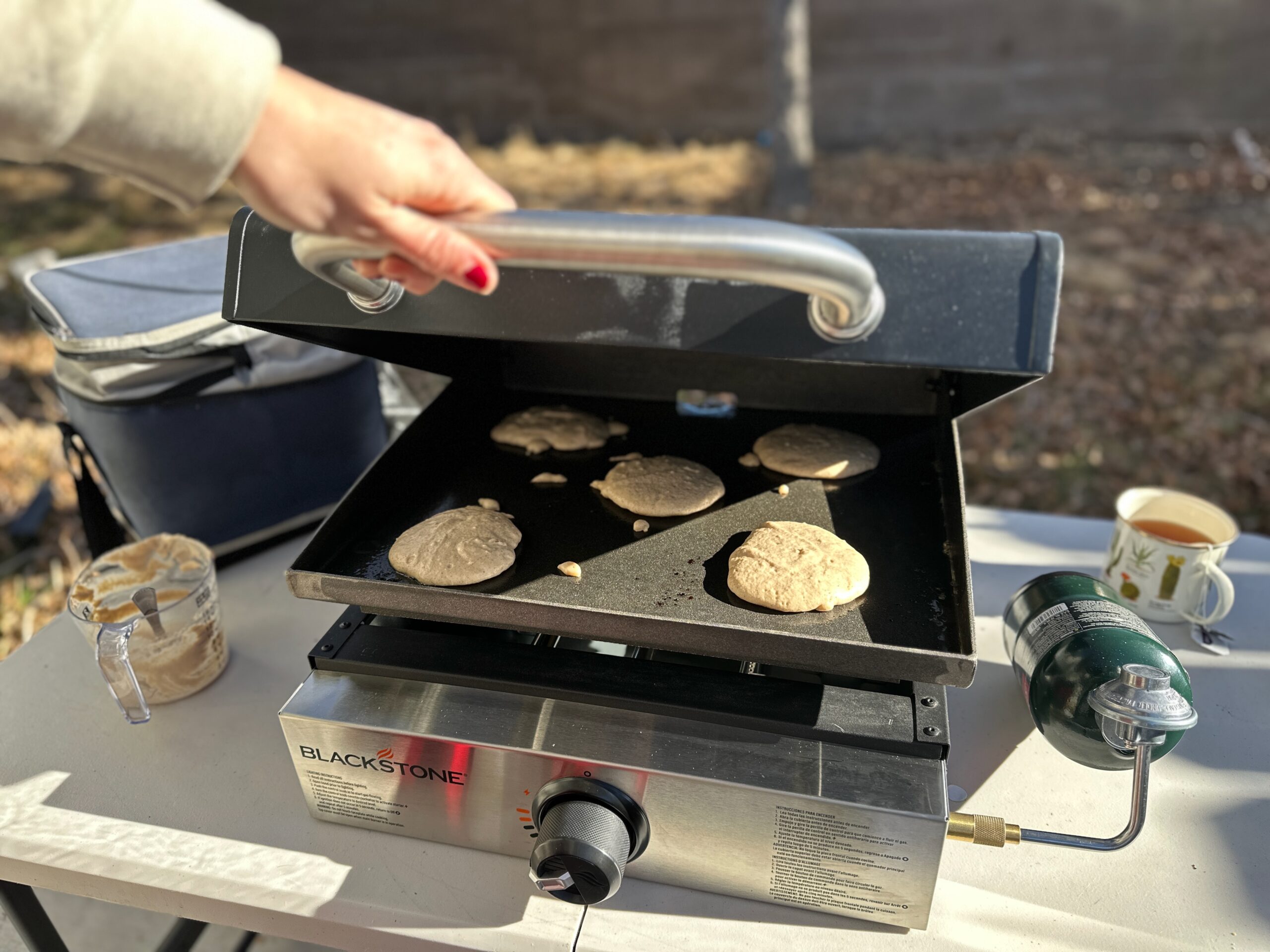
Analysis & Results
In this section, we turn up the heat and see which camping stoves burn brightest when it comes to boil time, fuel efficiency, simmer control, ease of use, and portability.
Power
Boil time gives us a direct comparison of stove to stove. While we can look at BTUs (British Thermal Units) as a measure of the power a stove delivers, it is only one aspect of the boiling time of each stove. For example, the Camp Chef EX60LW Explorer 2 Burner Outdoor Camping Modular Cooking Stove has a 30,000 BTU rating but boils a liter of water almost two minutes slower than the Snow Peak Home & Camp butane stove which only clocks in at 8,333 BTUs.
Similarly, the Coleman Classic 1-Burner Butane stove matches the Gas ONE GS-3400P in its BTU rating but, in our test, boiled a pot of water in almost double the time.
Snow Peak was the stove with the fastest boiling time (five minutes and eleven seconds) and the Coleman Classic 1-Burner Butane Camping Stove was the stove with the slowest boiling time (16 minutes and 8 seconds).
The second fastest boil came from the Camp Chef stove (six minutes and fifty-nine seconds). Its powerful flame did help speed up the boil time –– the flames surrounded the pot, even on medium heat. The Jetboil Genesis Basecamp System was third fastest (seven minutes and twenty-one seconds).
We don’t see boil time as a reason that everyone will choose to not buy or not buy a stove. The Snow Peak is a great option for those who want a stove that cooks quickly so that they can get back to other camp activities. For people who take meal time a bit slower, something like the Coleman Cascade 3-in-1 Camp Stove –– which is rated in the middle for boil time (nine minutes and twenty-four seconds) –– that offers more bells and whistles for more complex meals could be a better option.
EFFICIENCY
In addition to what our testing results suggest, we should note that there are significant differences between propane and butane. One of the most glaring differences is that butane does not work well in below-freezing temperatures.
For this reason, stoves that run exclusively on butane –– Coleman Classic 1-Burner Butane Camping Stove and Snow Peak Home & Camp butane stove –– aren’t as fuel efficient (or straight up won’t admit any gas to the stove) during low temperatures. We encountered this with the Snow Peak stove when we tried to cook bacon one morning in 24-degree weather. At first, the bacon first sizzled, but then went eerily quiet. We could hear the stove still running and see heat waves but there was little power behind it. It took over 30 minutes for our bacon to crisp up, meaning that this stove lost its spot at the top for fuel efficiency.
While our favorite wood-burning stove, Solo Stove Campfire, is deemed fuel efficient (because it runs on renewable resources), it might not be allowed in all campgrounds or dispersed areas…especially out West.
COOKING ABILITY
Stoves were awarded points for simmering ability, evenness of cook, windshields or other features to protect the flame, as well as for temperature range and easy adjustments.
The Snow Peak Home & Camp butane stove would have had a perfect score if it included some sort of wind guard –– again the price we pay for its light, portable design. We found that the stove was powerful enough and cooked quickly enough that a windshield wasn’t missed too much.
Of the stoves we tested, here are the ones that simmered the best and cooked a perfect pot of rice (in no particular order):
- Snow Peak Home & Camp butane stove
- Coleman Cascade Classic 2-Burner
- Coleman Cascade 3-in-1 Camp Stove
- Camp Chef EX60LW Explorer 2 Burner Outdoor Camping Modular Cooking Stove
Of those we tested that cooked evenly (in no particular order):
- Snow Peak Home & Camp butane stove
- Blackstone Original 17″ Tabletop Griddle with Hood
- Camp Chef EX60LW Explorer 2 Burner Outdoor Camping Modular Cooking Stove
Those that had windshields/flame protections (in no particular order):
- Blackstone Original 17″ Tabletop Griddle with Hood
- Coleman Cascade Classic 2-Burner
- Coleman Cascade 3-in-1 Camp Stove
- Coleman Classic 1-Burner Butane Camping Stove (kind of)
- Camp Chef EX60LW Explorer 2 Burner Outdoor Camping Modular Cooking Stove
Those with the best temperature range/adjustments (in no particular order):
- Snow Peak Home & Camp butane stove
- Blackstone Original 17″ Tabletop Griddle with Hood
- Coleman Cascade Classic 2-Burner
- Coleman Cascade 3-in-1 Camp Stove
- Jetboil Genesis Basecamp System
- Camp Chef EX60LW Explorer 2 Burner Outdoor Camping Modular Cooking Stove
The caveats in this final category are that the Coleman Classic 1-Burner Butane Camping Stove and Gas ONE GS-3400P do have temperature controls but didn’t feel accurate or helpful. Also, the Camp Chef does allow control over a great range of flame, but the flame even on low is crazy high.
Portability
Cooking ability might be one of the most important qualities a stove can deliver. That might sound obvious, but there are caveats. Take the Camp Chef EX60LW Explorer 2 Burner Outdoor Camping Modular Cooking Stove for example. This stove has incredible cooking ability –– it cooks fast, has good temperature controls, simmers a pot of rice well, and cooks evenly. All amazing qualities that, if you were just looking at that, you might say: “Well, yes, I’m buying this right now.”
However, this stove is incredibly difficult to pack. It doesn’t fold down, requires a propane tank to fuel it, and didn’t fit in our gear analyst’s car as it was packed for a camping trip.
The Snow Peak Home & Camp butane stove, however, could practically fit in a cup holder, making it a delightfully easy partner for simple, hot food. This stove gives up the ability to cook with more than one pot –– so it may not answer all your needs.
We believe that the average camper who cooks meals for 3-5 people would be more interested in either the Jetboil Genesis Basecamp System or the Coleman Cascade 3-in-1 Camp Stove because these stoves pack well but also have the space to cook more food.
EASE OF USE
When we rate ease of use, we think about stoves that need little to no explanation. A stove that a beginner camp stove user could pick up and get going without delaying dinner.
The stoves that rated the highest were the Coleman Classic 1-Burner Butane Camping Stove and Jetboil Genesis Basecamp System. These were awarded 5 out of 5 in this category because they embody all the qualities of ease: they are easy to assemble (including hooking up fuel), self-ignite, have a stable base for cooking and are simple to clean up.
The Solo Stove Campfire received the lowest score because it is not easy to ignite, not easy to clean, and doesn’t feel as stable as other stoves. For someone who is used to wood-burning stoves, however, this stove may be the easiest to use of all.
All other stoves rate fairly high in terms of ease of use, except the Snow Peak Home & Camp butane stove. We had to knock this stove down a bit because the stove isn’t intuitive to set up. With the help of the instruction manual that comes with the stove, you should be able to figure out how to set this one up relatively quickly. If you happen to take the stove to camp without its manual and prior testing, it would be very easy to miss the correct steps.
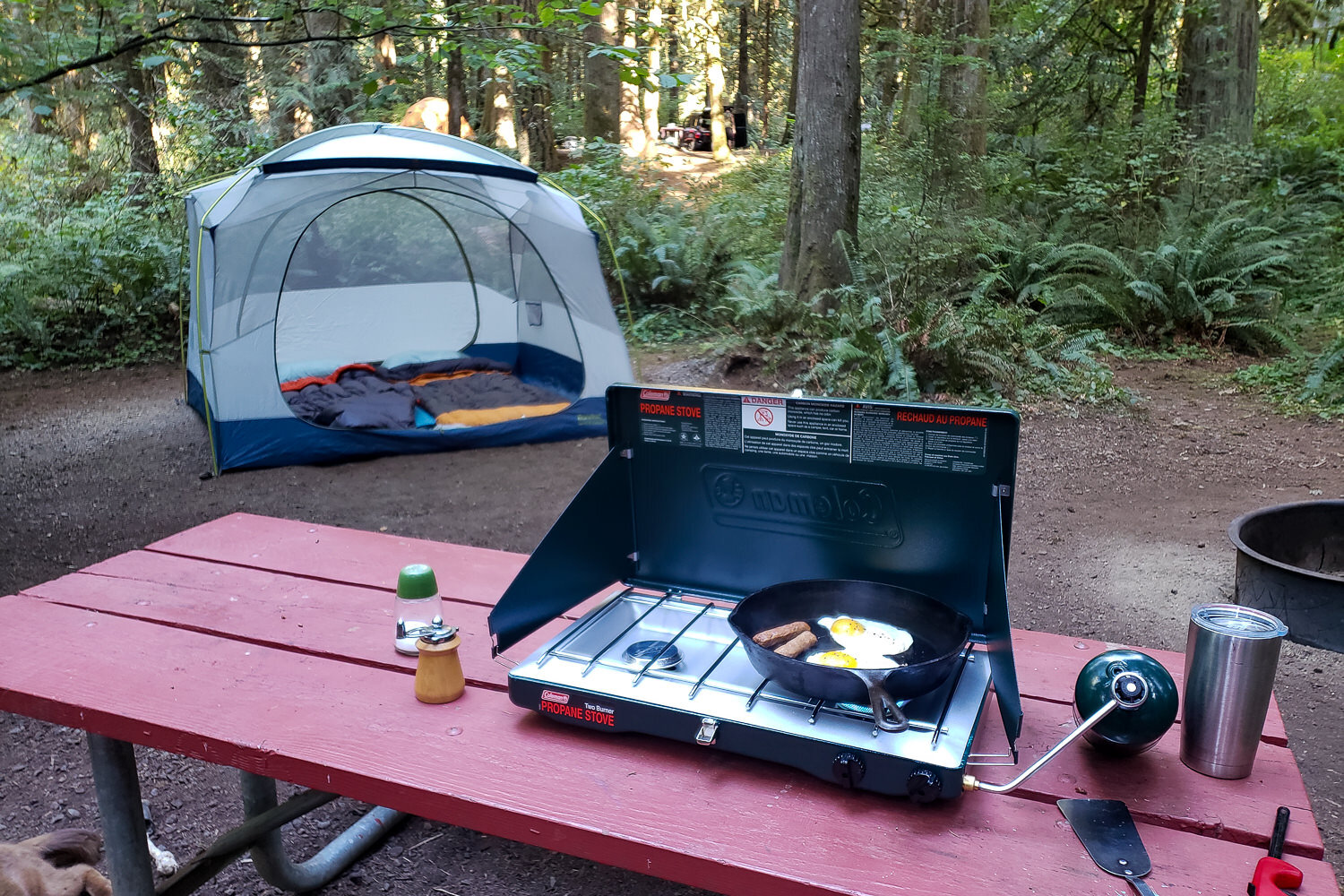
How to Choose a Camping Stove
There are many considerations to make when looking at investing in a new camp stove.
CAPACITY
One of the biggest considerations is the capacity you need out of a stove. We’ve tested single-burner and double-burner stoves; each has its merits.
The single-burner stoves are lighter, pack easier, and are great for solo or small camp groups who prioritize simple meals, like one-pot chili.
Double-burner stoves are better for groups of four or more or for those who like to make more complex meals –– like a breakfast with pancakes, eggs, bacon, and coffee.
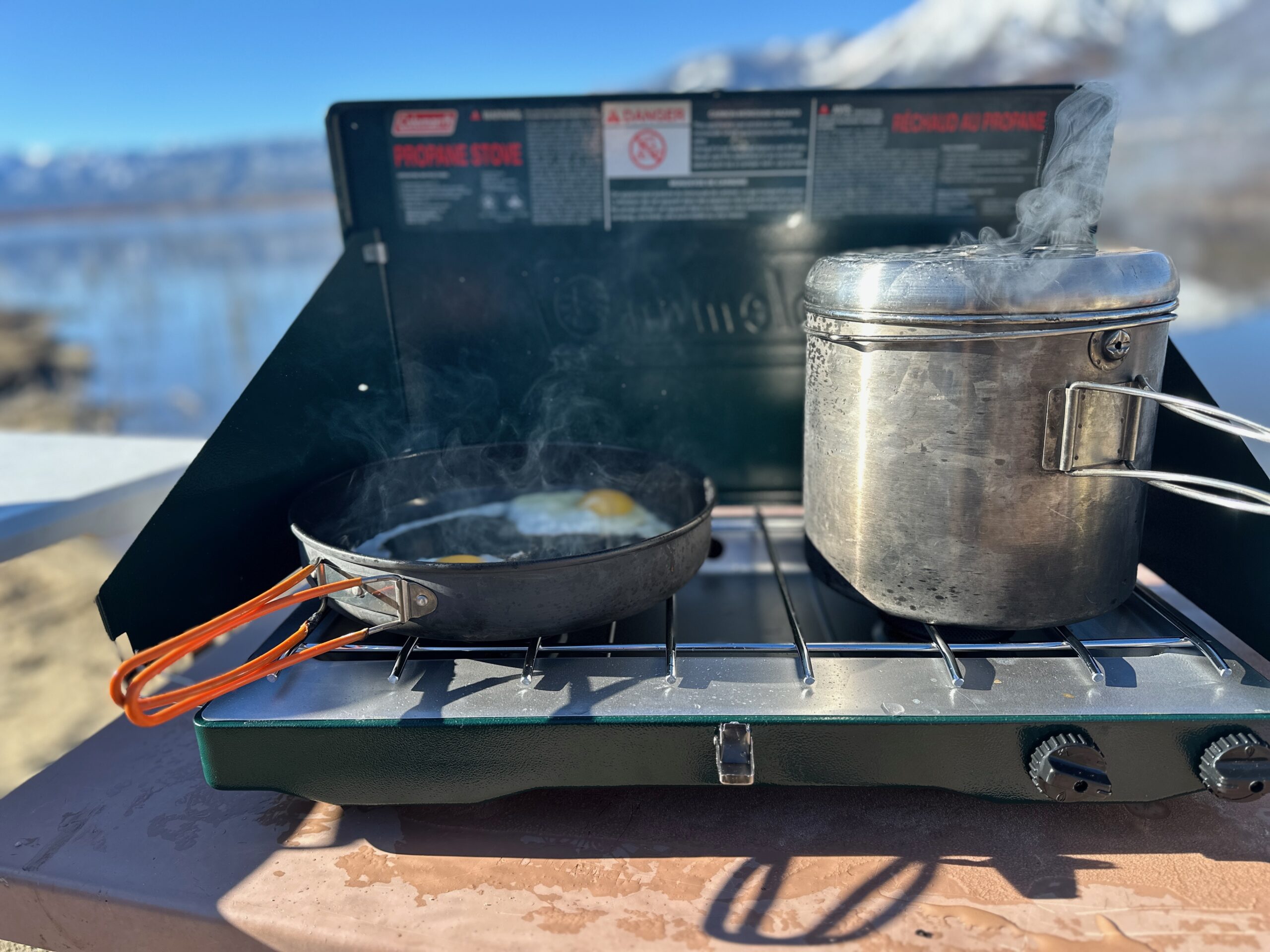
FUEL TYPE
Another important consideration is the fuel type that best suits your camping habits. Generally, we recommend propane stoves for the best overall fuel type that works in a variety of temperatures and environments. However, if you plan on only camping during the summer, a butane stove might be a good option. If you plan on camping year-round or at higher altitudes, consider a propane stove instead.
Butane becomes a gas at 32 degrees and effectively stops working at cold temperatures (see our review of the Snow Peak Home & Camp butane stove for more information on this). Butane also loses performance at altitudes of 6,000 feet or higher, whereas propane still works well at high altitudes. However, butane outperforms propane in weight and efficiency, meaning it will last longer ounce for ounce than propane.
Wood-burning stoves don’t require extra trips to the store, and don’t burn gas into the atmosphere, but can be a pain to rely on. You have hope that you can find the fuel you need and in useful enough quantities. If the environment is wet, you might be out of luck with a wood-burning stove unless you pack wood chips.
You also have to monitor wood-burning stoves more to ensure a consistent flame. Lastly, be mindful of your camping area’s restrictions on wood-burning stoves. Some places do not allow stoves like these because their flame produces sparks and cannot simply be “turned off” like a propane or butane flame could.
However, wood-burning stoves are great for those who are looking for a fire pit as well as a cooking solution. These stoves also work through any weather conditions and altitudes, and they provide a more sustainable option as they use a renewable resource. Wood-burning stoves are also useful when traveling in very remote or foreign areas, where other fuel sources may not be available.
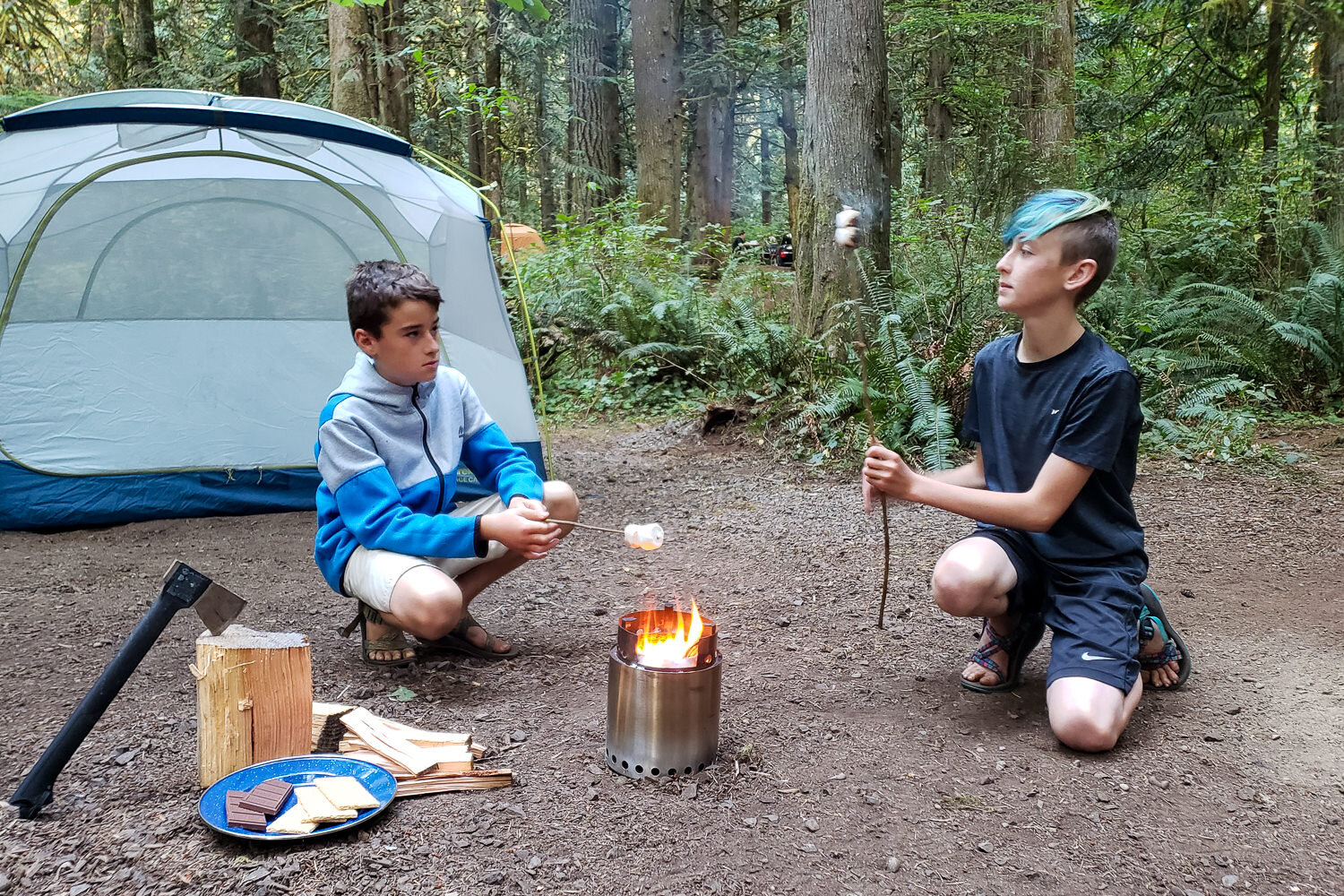
VERSATILITY
The last major consideration when looking at buying a stove is the versatility of the stove. Stoves like Camp Chef EX60LW Explorer 2 Burner Outdoor Camping Modular Cooking Stove or Coleman Cascade 3-in-1 Camp Stove provide options for grills, flat-top griddles, and traditional burners.
These accessories make these stoves attractive for situations outside of strictly camping. If you see yourself using a camp stove for tailgating or at home, a more robust stove with versatility like this might be a better choice for you.
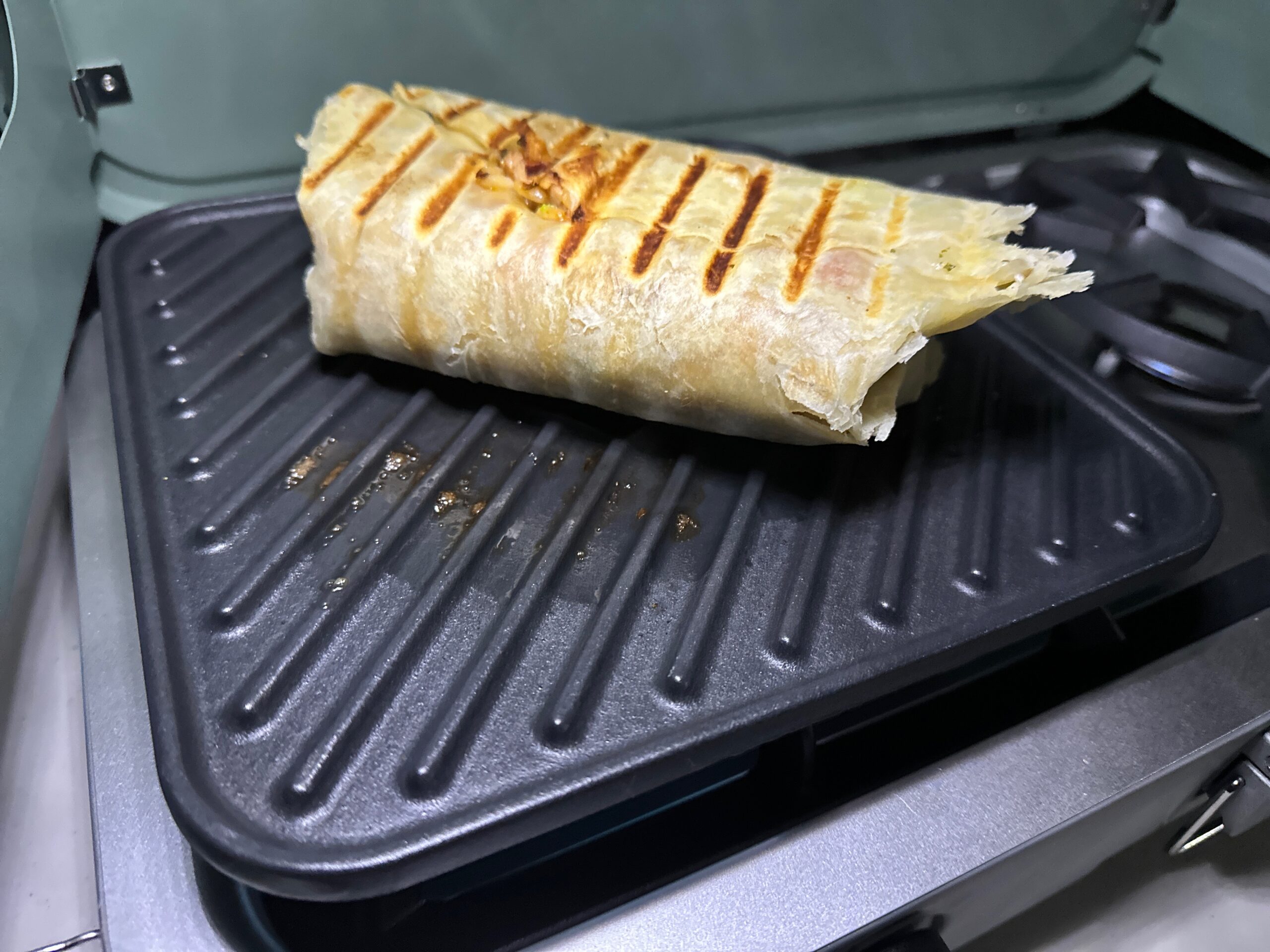
POWER
The more BTUs (British Thermal Units) a stove has, the hotter it burns. The average tabletop camping stove has around 10,000 BTUs per burner.
For up to three or four people, that’s sufficient for most camper’s needs and provides a good balance of power to fuel efficiency. However, you may want to bump up the BTUs if you’re cooking for a large group or will be camping in cold, windy conditions.
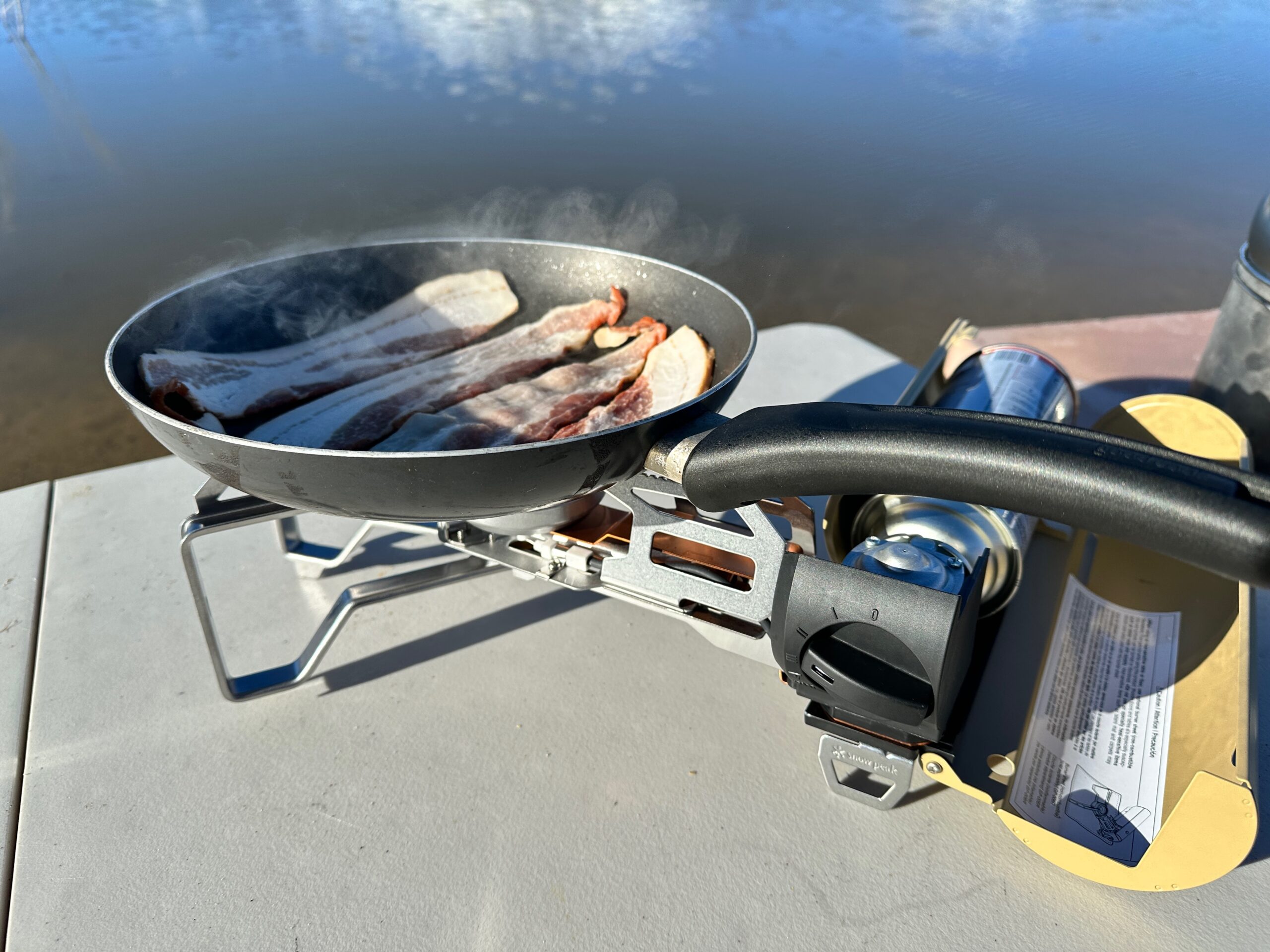
PRICE
Quality camping stoves are expensive, but if you spend a lot of time cooking in your outdoor kitchen, it’s worth investing in a stove that you really enjoy using and will last for years – if not decades. The higher the price tag is the more heat the stove puts out, the more control you have over the size of the flame, and the bigger the cooking area will be. That said, you’ll find outstanding stoves at every price level.
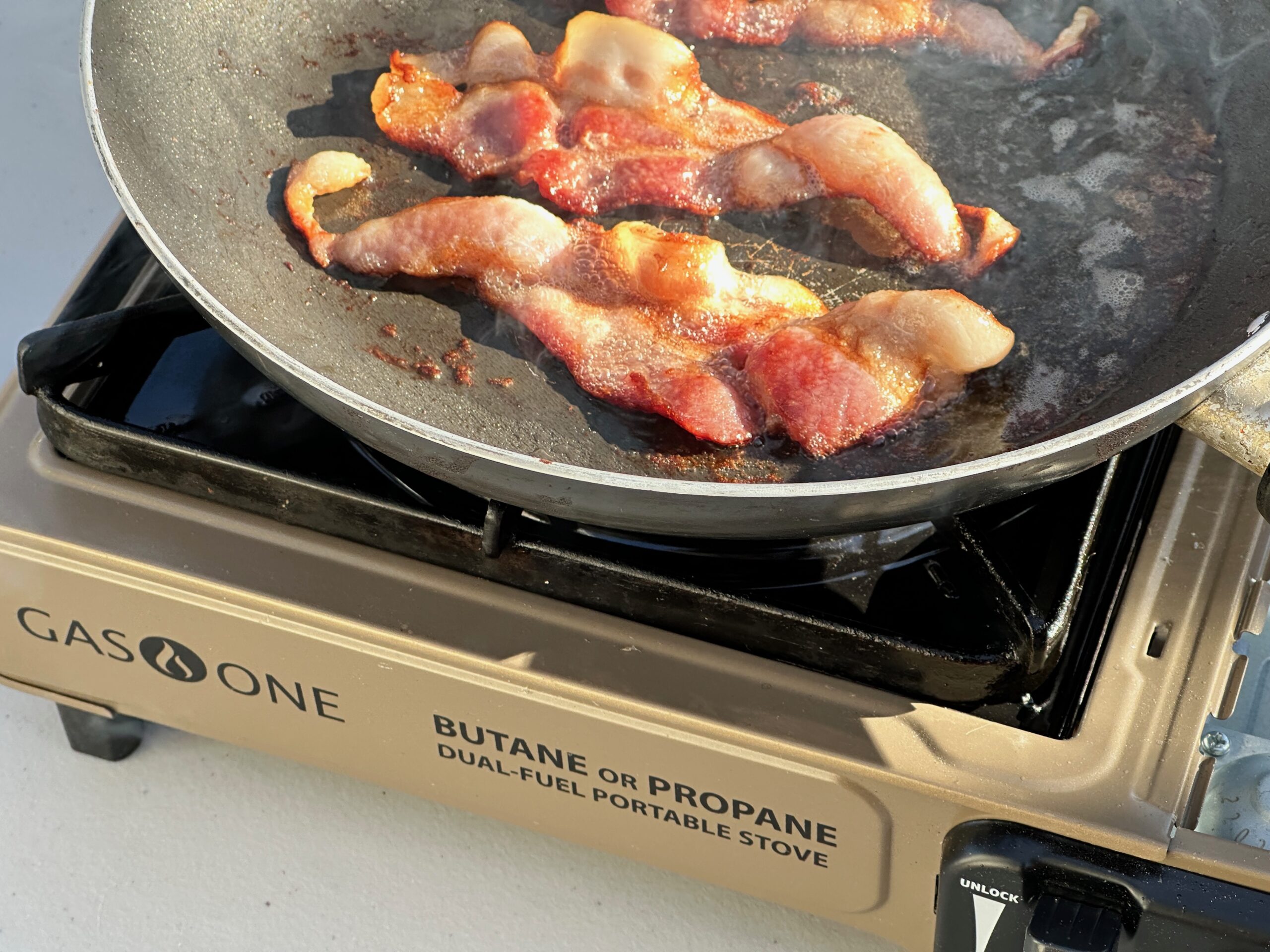
COOKING AREA DIMENSIONS
Consider what you like to eat while camping and the cookware you’ll use. If you’re serving more than four people or cooking up multi-stage gourmet meals, you’ll probably be using multiple pots or fry pans at once. In that case, it’s best to choose a stove with a spacious cooking area, multiple burners, and more than one cooktop option to avoid overcrowding – and to do your recipes justice. In contrast, if you only want to boil water, reheat prepared food, or do light cooking, a smaller, light-duty camping stove will be more convenient and less cumbersome.
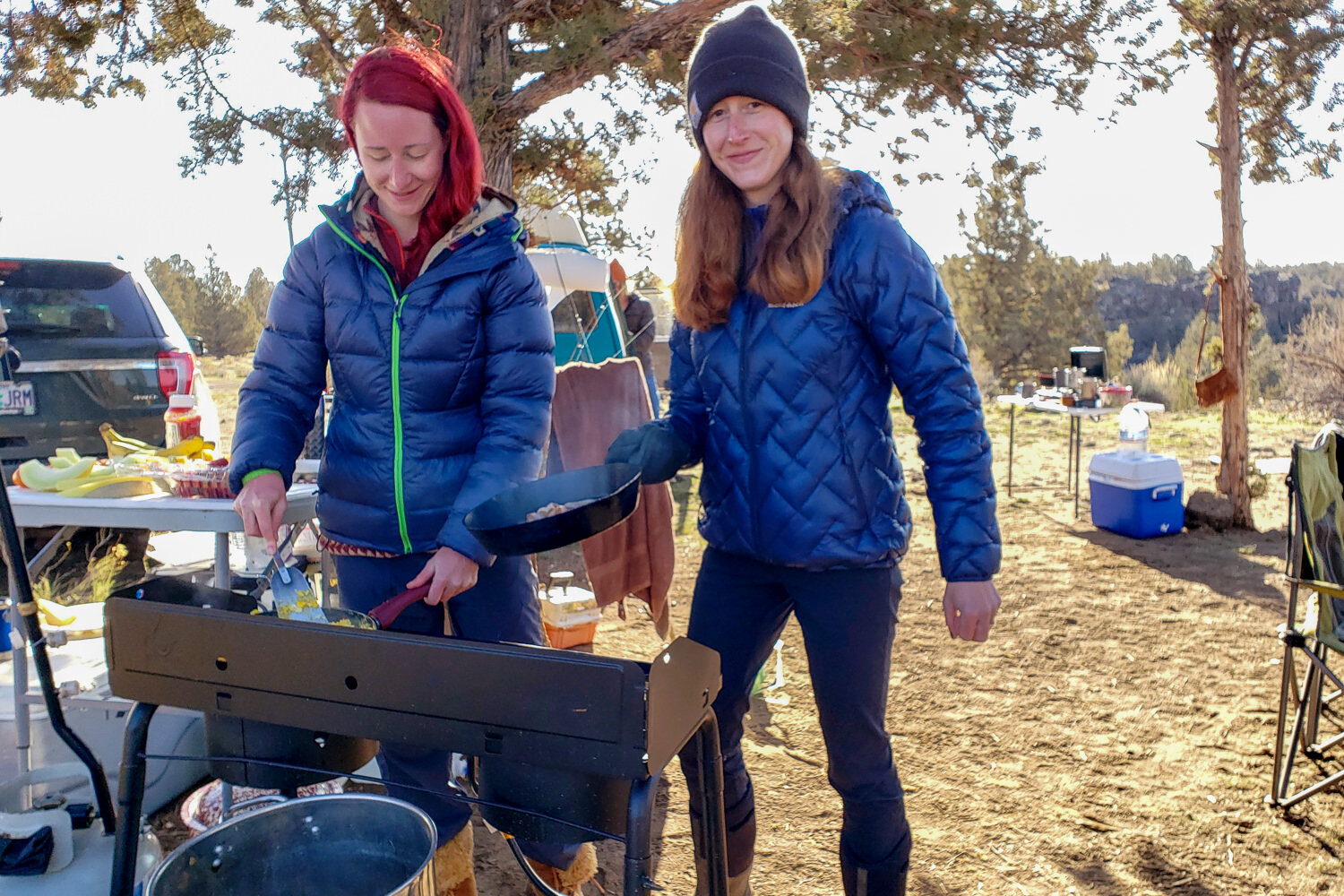
Conclusion
We’ve evaluated these nine stoves for power, efficiency, cooking ability, portability, and ease of use through our rigorous testing process. We’ve taken into consideration other factors, like fuel type, to provide realistic recommendations.
Above all, we looked at each of these stoves through the lens of a beginner stove user to provide recommendations that work for those just beginning their outdoor cooking journey, as well as seasoned camp chefs.


